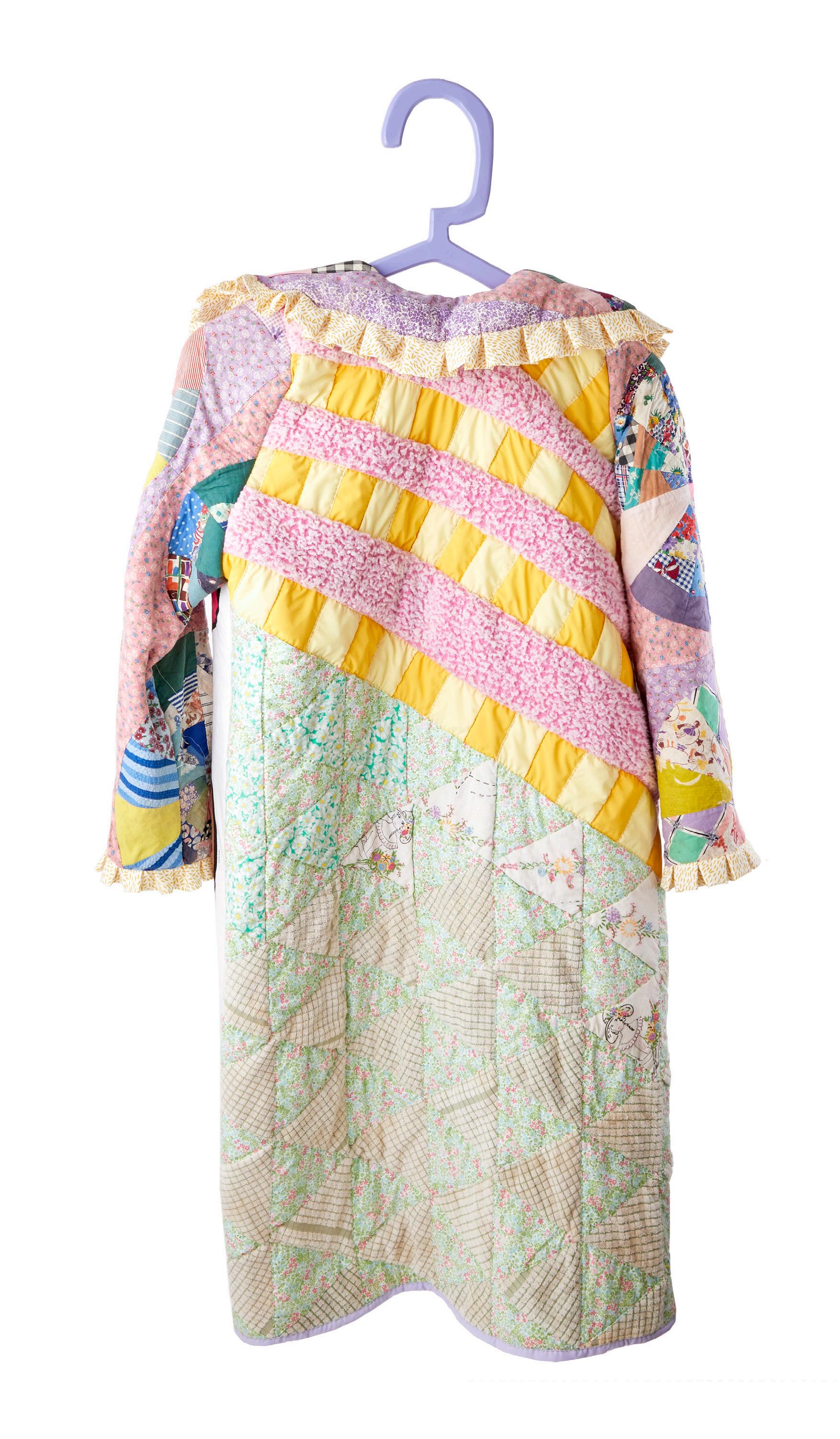Appalachia in Focus



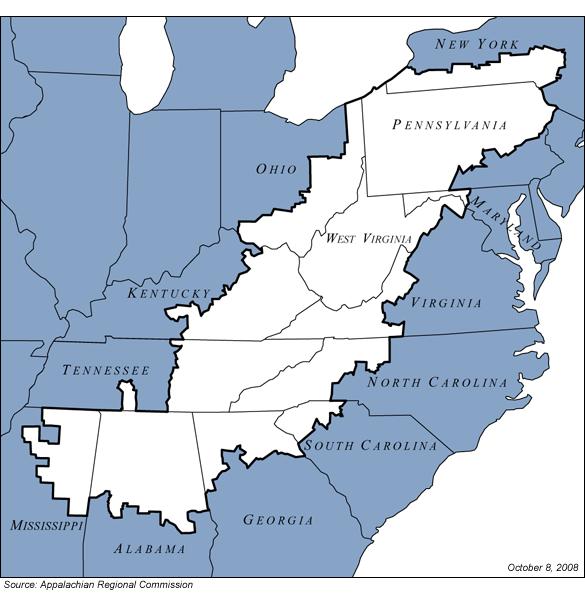
In conjunction with the Journalism Department
Appalachia is a mountainous area of the Eastern United States spanning 13 states from the southern edges of New York to the northernmost reaches of Georgia and Alabama. This exhibition celebrates the activists, artists, and intellectuals who enrich their region with creativity, culture, and art. Through the diverse perspectives of these artists, we hope to convey the complexity of this region, and by doing so familiarize viewers with its impact and history.
Rather than rely on tired stereotypes of this region’s struggles, this exhibit draws on the talents of artists, writers, filmmakers, and common individuals. We invite you to learn about the rich history of this area from the natives best qualified to tell it.
Special thanks to: Michael Croley, Jack Shuler, Doug Swift; William Isom II Director, Black in Appalachia; Elon Justice, Creator, The Appalachian Retelling Project; and Ashton Marra, Executive Editor, 100 days in Appalachia.
The Denison Museum interns: Maya Barlow, Ellie Blasko, Emma Driver, Talia Ferguson-Nieves, Ava Goodwin, Emily Harris, Anne Mattoni, Allie Mohn, Isabelle Monyak, Dana Randall, Ellie Schrader, and Elizabeth Sullivan.
Please see the Museum website for information regarding exhibition related events. DenisonMuseum.org Museum@denison.edu
Listen to the music of the region: put together by Talia Ferguson-Nieves ‘23

Location:
Born in KY lives inWassaic, NY
Women and Gender identity, sterotypes, Craft vs fine art, home
Natalie Baxter was born in Lexington, Kentucky where she discovered her love of sewing and quilting. Baxter received her MFA from the University of Kentucky BA in Fine Art from the University of the South in Sewanee, TN. She currently lives in Wassic, New York and has been featured in countless exhibitions in the USA and abroad.
Housecoat IV, 2021, found quilts, laundry bag, dish towels, graphic t-shirt, hospital receiving blanket, fabric, plastic zipper, cotton batting 60x 32x6 inches. courtesy of the artist
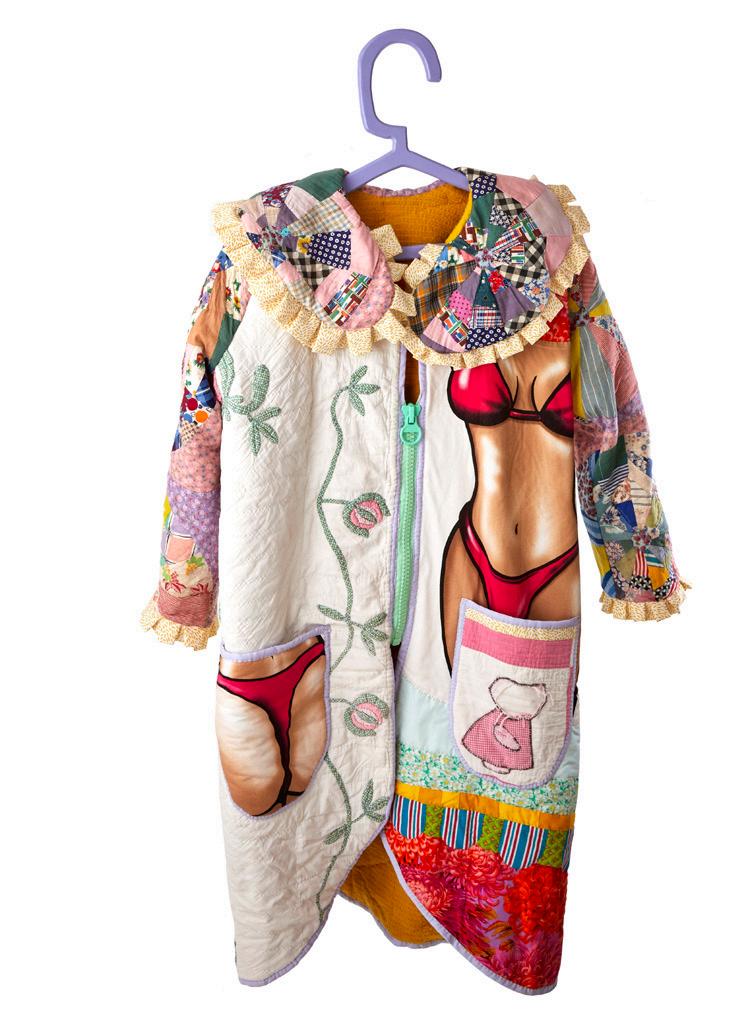
Work Description:
All Out / All In Interview with Joe Brommel, January 2021
“My maternal grandmother who taught me to quilt and sew spent her days cooking, baking, gardening, cleaning, and raising three children. She often wore housecoats that I viewed as a kind of homemaker workwear — she had this closet of them and would offer them to me to wear when I was at her house. She didn’t work outside the home, but would sometimes take jobs sewing for people in her community. She didn’t get to further her education beyond eighth grade because only boys went to high school. That was the life she lived.
So I started thinking about her life and about housecoats a year and a half ago, when I had my daughter, because you’re very homebound after you have a child...I went down this thought process that I think a lot of artists working with craft mediums grapple with, about the blurred, made-up line of craft and art. My sisters and I were all expecting babies, and I started making quilts for them from scraps in my studio. I really enjoyed the meditative and creative process of quilting, but as I was making these quilts, I was like, Oh, this is not my work. This is craft. This is a quilt. This is a functional object. But then I was like, Why is this not my work, though? Is it because they have less of a concept? It’s just decorative. Is it because they’re functional? Is it because quilting is women’s work traditionally? If I were a painter, these quilts would be called studies, and there’d be no question they were quote-unquote art because they’d be on a canvas.
At this point, I knew I wanted to make work using the imagery of a housecoat, and since these ideas were swimming around in my head, I tried to make a quilt version with a housecoat image relief and then stretch them onto a canvas stretcher to read as a painting. But I just really didn’t like what they looked like. It took a long time to reach that point of, Just make a housecoat.” - Natalie Baxter
Location:
Black in Appalachia
Throughout Appalachia
TOPICS:
Black history, religion, education, American history.
Black in Appalachia: Research, Education & Support is a non-profit that works in collaboration with public media, residents, university departments, libraries, archives and community organizations to highlight the history and contributions of AfricanAmericans in the development of the Mountain South and its culture. We do that through research, local narratives, public engagement and exhibition. Black in Appalachia is a community service for Appalachian residents and families with roots in the region.Southeast Ohio Project, video, 23mins courtesy of Black in Appalachia
Links:
Work Description:
In 2017, Black in Appalachia began documenting African American life and history in Lawrence, Gallia, Athens & Perry Counties, with a particular focus on the region’s Emancipation Proclamation celebrations. Those events in Gallia County, Ohio hold the distinction of being the oldest continually celebrated Emancipation Day gatherings in the United States, begun on September 22, 1863.
Once we arrived in the region and began talking with residents, we quickly understood the vast and impressive narratives associated with Black life from the early 1800’s until today. The unique confluence of Free Black communities, large numbers of United States Colored Troops during the Civil War, as well as the strong economic, intellectual, cultural and social infrastructures have helped to cultivate a massive network of communities of Color with ripples beyond it’s geographic footprint. These communities were coal and lumber camps, iron forges, underground railroad stops, bastions against slave-catching paddyrollers, agricultural operations and hubs for intellectual and religious thought.
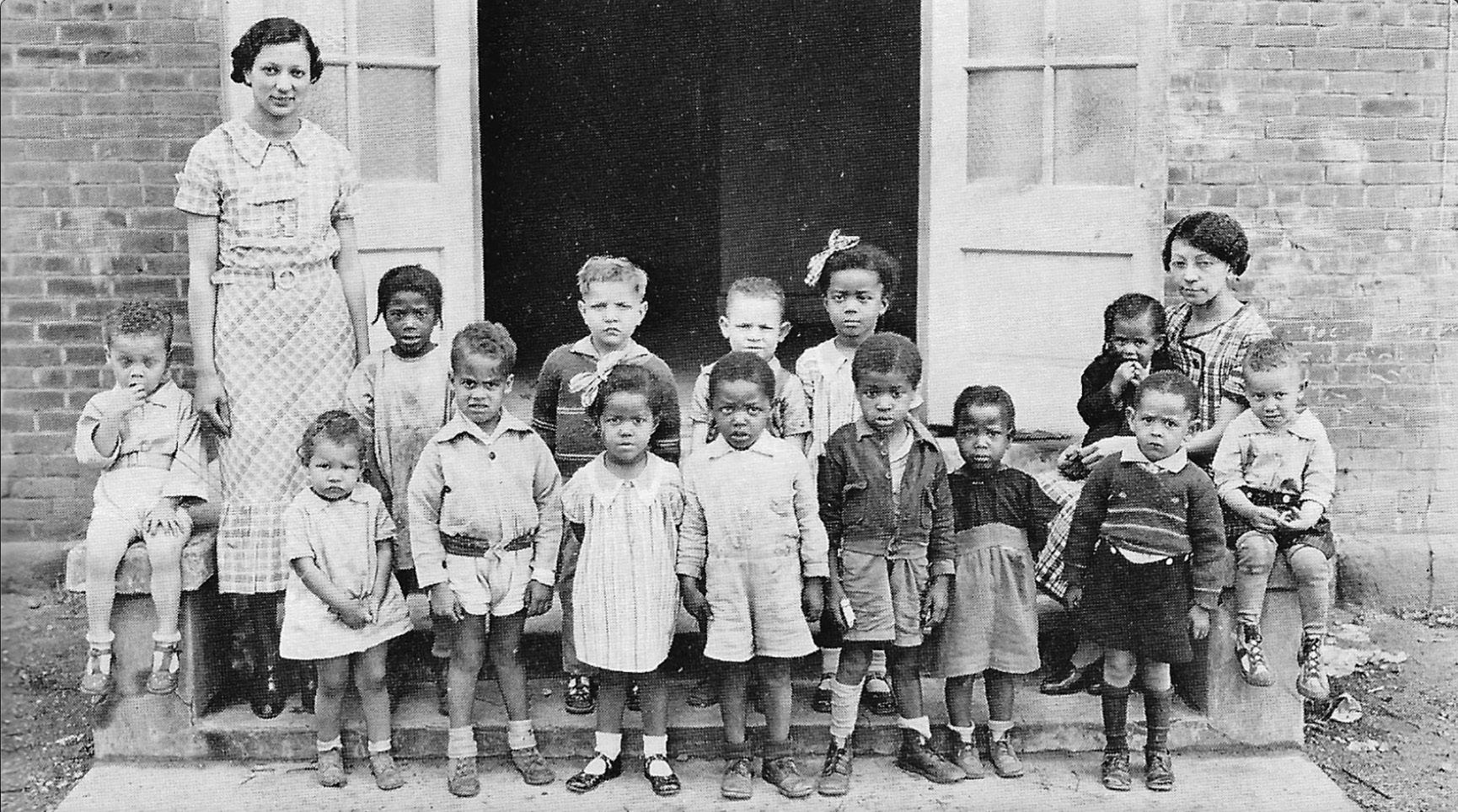
These stories of Appalachian Ohio do not need our assistance in researching, uncovering and preservation. They know, teach and maintain their own spaces and family histories. Rather, Black in Appalachia’s work in this region consists of:
• Development of a documentary on the September 22nd Emancipation celebrations. Emancipation Proclamation Celebration & Historic Sites Gallia & Lawrence Counties, Ohio: 2017 - 2019
• 200th Anniversary of Union Baptist Church, Blackfork, Ohio
• Modern documentary photography of current communities with historical Black significance
• Technical and resource support for communities to cultivate and develop younger leaders in the preservation processes
Artist Name
Chase BowmanPrinceton, WVLocation:
Kind of a Heaven, 2021 mixed media, dimensions variable courtesy of the artist
Work Description:
TOPICS:
Queer identity, comic books, space and place, beauty
Artist Bio:
Chase Bowman was born in Princeton, West Virginia and received his MFA from Columbus College of Art and Design in 2014. Chase returned to his hometown where he hosts art-making workshops, teaches art at Concord University, and opened Holler gallery.
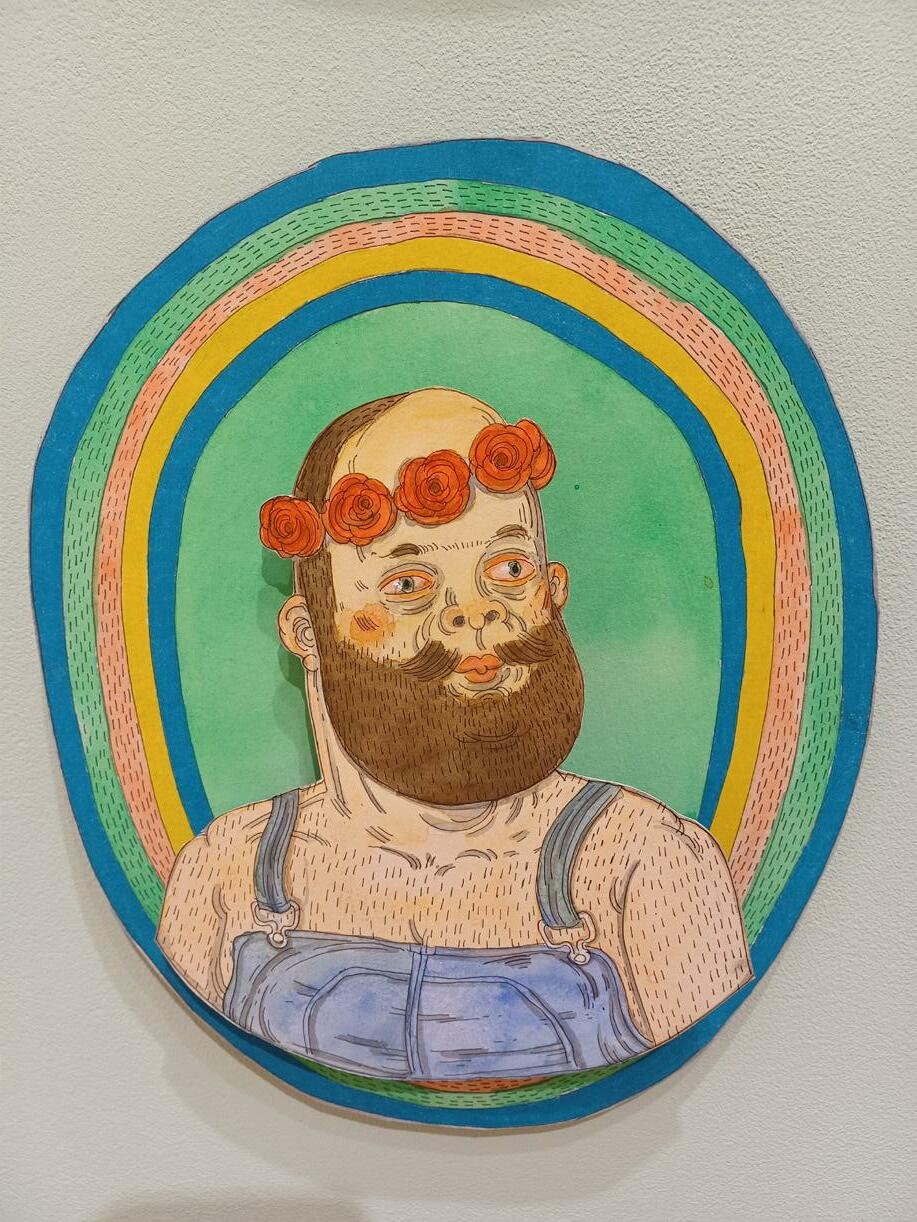
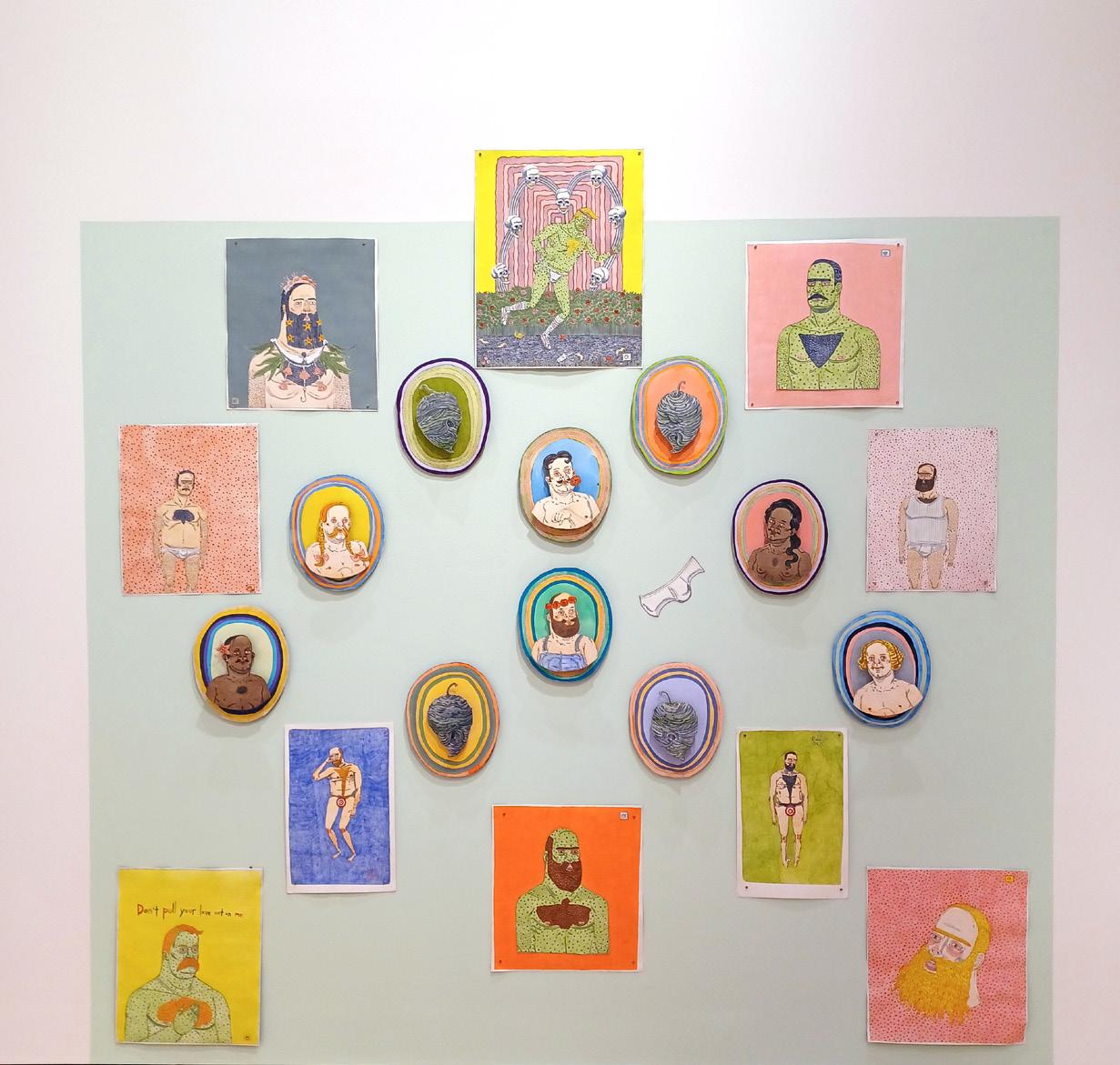
Links:
http://www.oddygumption.com/ https://www.ccad.edu/blogs/move-overjd-vance-new-voice-appalachian-culture
Growing up without art classes in school, Chase learned to draw by reading the “How To Draw” section at the back of the comic books he bought at the local pharmacy. His work is inspired by the aesthetics of older comic books and pulls specifically from the styles and themes of feminism and sexuality in the original Wonder Woman comics. He primarily works within the drawing to express the beauty and complexity of the Appalachian region.
Artist Name
Danielle BurkeCarrboro, North CarolinaLocation:
Resiliency (Part I of II): Linum usitatissimum
2016, 47” x 45”
Natural and deconstructed linen
Resiliency (Part II of II): Linum usitatissimum
2018, 55” x 41”
Natural and deconstructed linen
Resiliency (Star Constellation): Linum usitatissimum
2018, 47” x 41”
Natural and deconstructed linen courtesy of the artist
TOPICS:
weaving, enviroment, DNA, gene, plants (flax seed)
Artist Bio:
Currently living in Carrboro, NC, she uses her loom work to highlight history and uses it to explore how textiles can tell stories. She received a BFA in Fiber and Humanistic studies at the university of Maryland. Now, she is currently work ing to earn her Masters in Folklore at the university of North Carolina, Chapel Hill. https://daniellelouiseburke.com/CV
Links:
https://daniellelouiseburke.com/Li num-usitatissimum
Work Description:
For this series, a segment of flax-linen DNA was transcribed for an 8-harness loom. The gene woven, whose specifics can be found below, has been associated with the plant’s resiliency during drought and environmental stress. Woven in overshot, a technique used in traditional Appalachian coverlets, the structure of the gene can be visualized, repeated, and inverted.
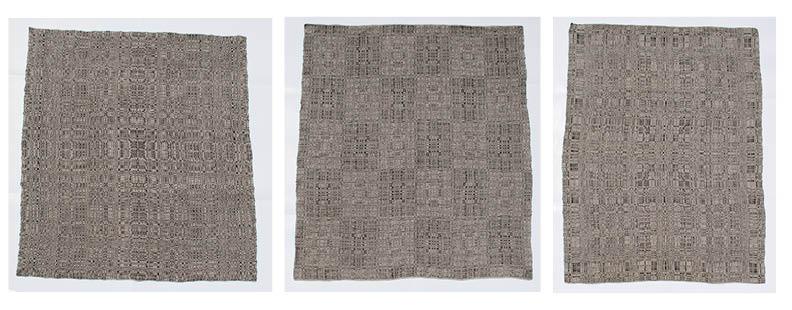
Organism: Linum usitatissimum
Lus10013166
protein (JAZ)
Born Taiwan, lives Boone, North CarolinaLocation:
TOPICS:
place, hair, environment, nature, people and places, geography, cultural heterogeneity, communication
Born in Taiwan, Hui Chi Lee currently lives in Appalachia and works at Appalachian State University as an assistant professor in studio art. She completed her Bachelors of Fine Arts at the University of Arizona and her Masters of Fine Arts at the University of Florida. Within her teaching and own personal art she focuses on the mediums of drawing, painting and mixed media. Her artwork has been featured in multiple exhibitions and galleries around the United States as well as Europe and Asia.
Links:
Pencil & colored pencil on paper, 28” x 38”, 2017 courtesy of the artist
Artist Bio: Work Description:
http://huichilee.com/new-gallery
“Having lived in Boone for the past 6 years, coming from an urban area to live in Appalachia made me shift a literal and symbolic principal in my work -- previously I looked at hair in long continuous lengths to reflect a cultural homogeneity to now using masses of entwined and tangled hair to show cultural heterogeneity and interdependence. For a long period of time and on a weekly basis, I collected hair from stylists in the Boone, NC community who were so helpful by saving their clippings in large plastic bags, which I would then clean and dry. At the beginning, when I would open the bags, the experience of seeing large masses of human hair was very disconcerting – the smell, sight, and texture were both foreign and yet familiar – but the ways in which hundreds of thousands of strands of hair of varying length, color, and texture formed together immediately reflected a microcosm of our landscape.
At the very earliest stage of creating this recent series, there were many technical challenges that had to be overcome – put simply, how to draw an almost infinite number of short, pointed, spiky hair fragments. I had to use close, concentrated observations and study how to draw fragmented hair, piece by piece, in a meticulous manner to achieve differentiation from a mass. I also drew inspiration by thinking about what is meant when an image “goes viral” on social media – how meaning is attributed to a visual image that is often devoid of context, and how viewers strive to create a context so that an image is grounded in something familiar and thus gains meaning. In this series, piles of human hair are styled into sculpture-like forms, and juxtaposed with various objects to elicit possible conversations that I personally care about and see from my daily life since living in Appalachia or after the pandemic hit.
I used the title “Mountaineers’ Dialogue’ to suggest both our comparatively isolated geography, our interdependence and the ways in which we communicate, and our heterogeneity that is often not readily apparent to those outside the region.” - Hu Chi Lee
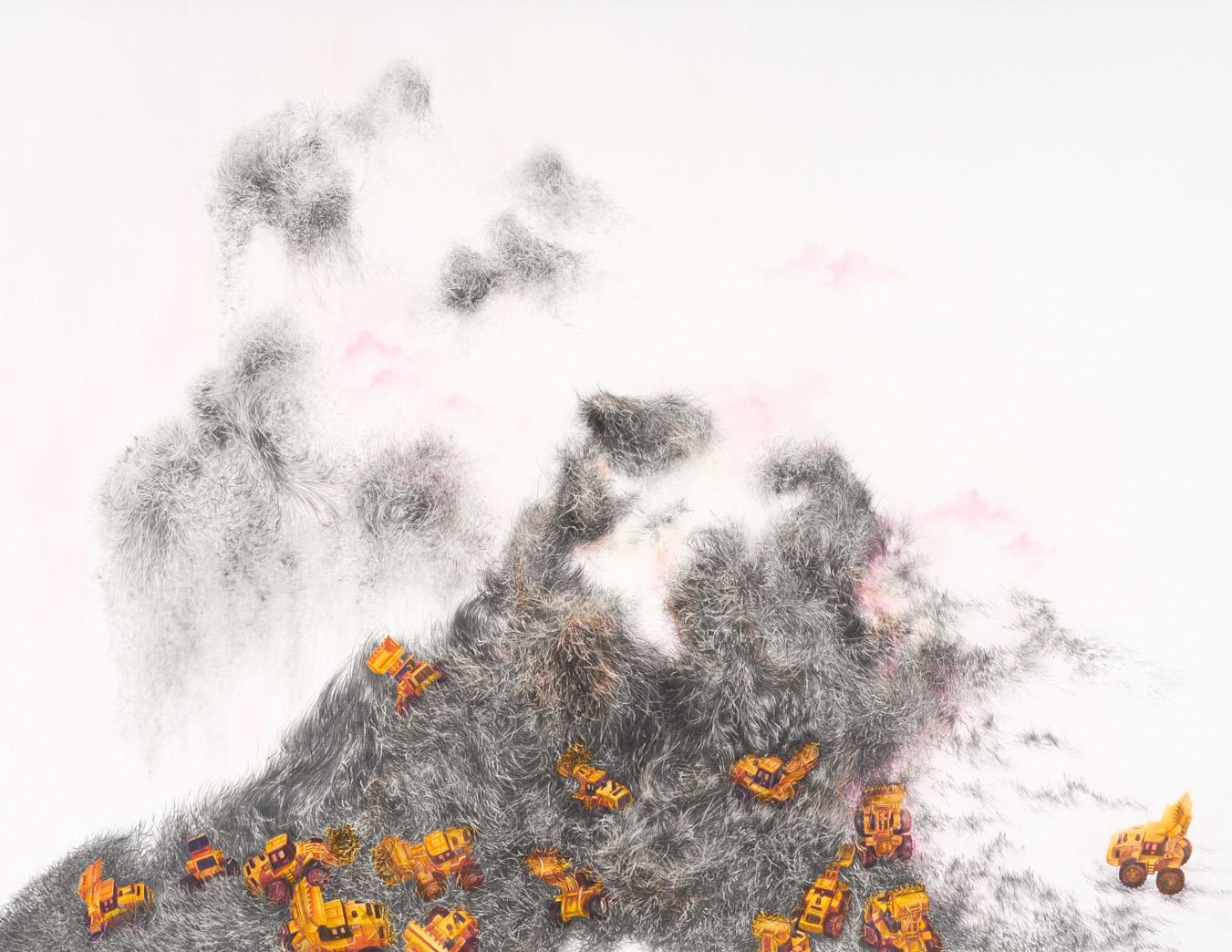
Born Taiwan, lives Boone, North CarolinaLocation:
TOPICS:
place, hair, environment, nature, people and places, geography, cultural heterogeneity, communication
Born in Taiwan, Hui Chi Lee currently lives in Appalachia and works at Appalachian State University as an assistant professor in studio art. She completed her Bachelors of Fine Arts at the University of Arizona and her Masters of Fine Arts at the University of Florida. Within her teaching and own personal art she focuses on the mediums of drawing, painting and mixed media. Her artwork has been featured in multiple exhibitions and galleries around the United States as well as Europe and Asia.
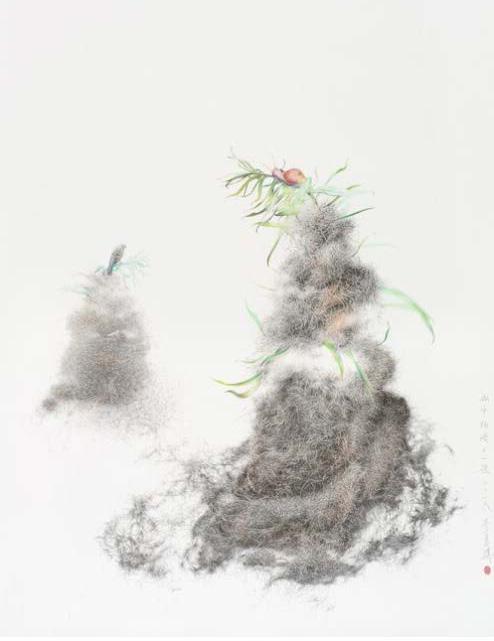
Links:
Graphite & colored pencil on paper, 28” x 38”, 2019 courtesy of the artist
Artist Bio: Work Description:
http://huichilee.com/new-gallery
“Having lived in Boone for the past 6 years, coming from an urban area to live in Appalachia made me shift a literal and symbolic principal in my work -- previously I looked at hair in long continuous lengths to reflect a cultural homogeneity to now using masses of entwined and tangled hair to show cultural heterogeneity and interdependence. For a long period of time and on a weekly basis, I collected hair from stylists in the Boone, NC community who were so helpful by saving their clippings in large plastic bags, which I would then clean and dry. At the beginning, when I would open the bags, the experience of seeing large masses of human hair was very disconcerting – the smell, sight, and texture were both foreign and yet familiar – but the ways in which hundreds of thousands of strands of hair of varying length, color, and texture formed together immediately reflected a microcosm of our landscape.
At the very earliest stage of creating this recent series, there were many technical challenges that had to be overcome – put simply, how to draw an almost infinite number of short, pointed, spiky hair fragments. I had to use close, concentrated observations and study how to draw fragmented hair, piece by piece, in a meticulous manner to achieve differentiation from a mass. I also drew inspiration by thinking about what is meant when an image “goes viral” on social media – how meaning is attributed to a visual image that is often devoid of context, and how viewers strive to create a context so that an image is grounded in something familiar and thus gains meaning. In this series, piles of human hair are styled into sculpture-like forms, and juxtaposed with various objects to elicit possible conversations that I personally care about and see from my daily life since living in Appalachia or after the pandemic hit.
I used the title “Mountaineers’ Dialogue’ to suggest both our comparatively isolated geography, our interdependence and the ways in which we communicate, and our heterogeneity that is often not readily apparent to those outside the region.” - Hu Chi Lee
Location:
Bobby T. LuckBorn PA, lives in Chicago, IL
TOPICS:
Zine, personal essays, Queer Identity, Black identity, decolonizing modern imagery and media
Artist Bio:
Bobby T. Luck currently lives and works in Colombus, Ohio. His primary mediums are film, multimedia collage, and instilation. He recived honors from The Community Collage of Philadelphia and has had his work featured in many solo and group exhibitions.
Links:
https://www.bobbytluck.com/work/ comp-zine
Zine, Physical and Digital Collage, Text, 8.5x11, 2019 courtesy of the artist
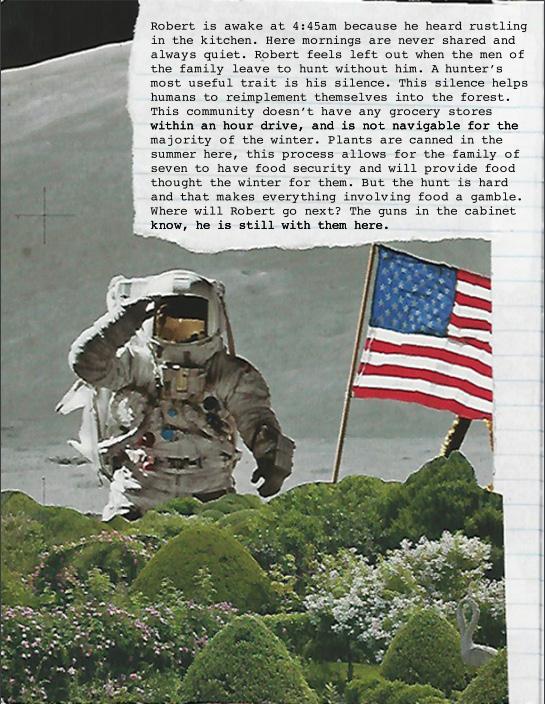
Work Description:
“A gathering of personal essays and collaged imagery that explore the artist’s childhood associations with the consumption of classic 90’s televi sion sitcoms, black culture in media, and the decaying implied ideals of the African American familial construct, which is force fed through the hands of the state.” - Bobby T. Luck
Clearfield, PennsylvaniaLocation:
The Most Beautiful Bumpkin, 2018 Gouache on paper
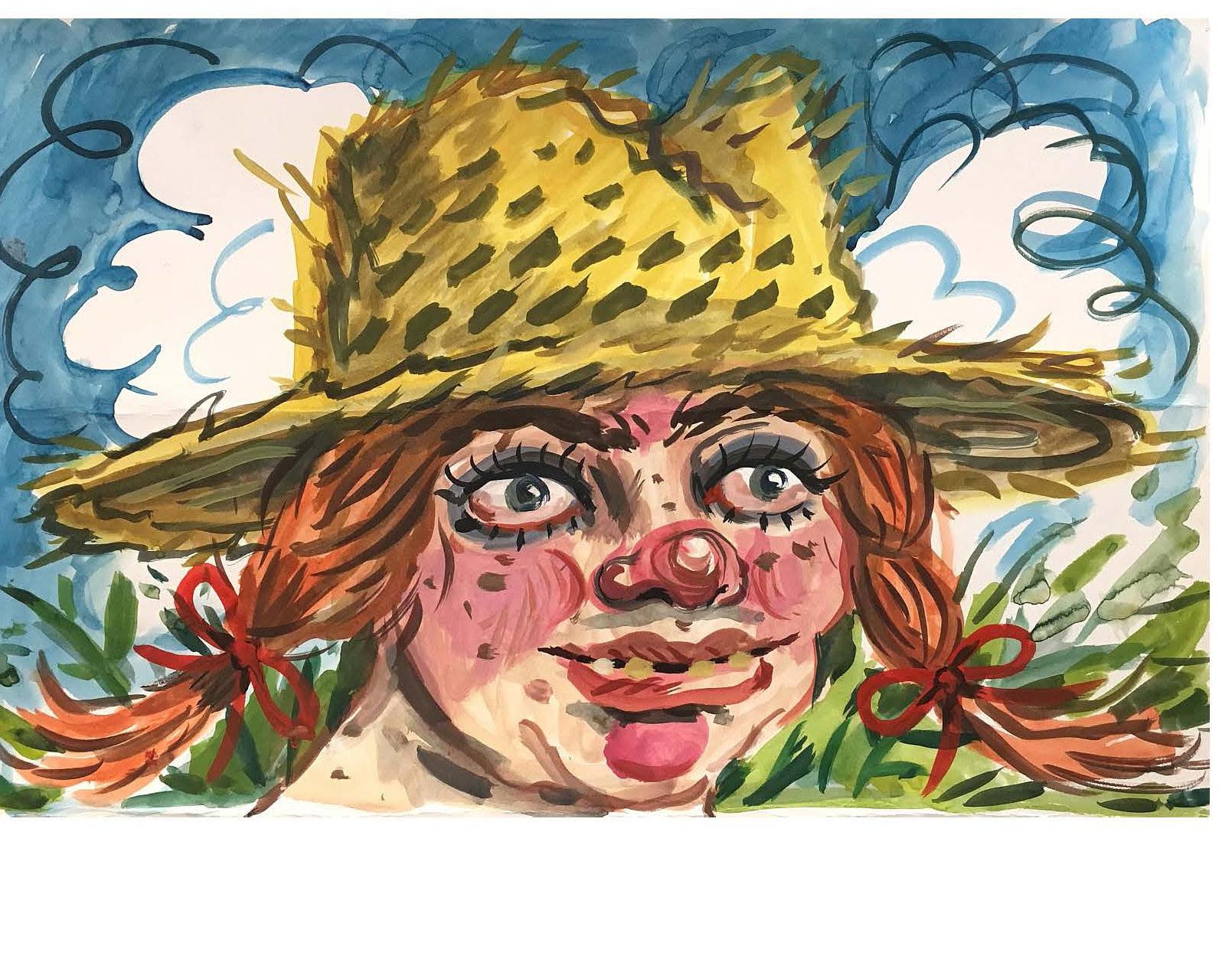
12.25h x 19w in, 31.12h x 48.26w cm, courtesy of the artist and and Asya Geisberg Gallery
Work Description:
TOPICS:
Women and Gender streotypes, body
Artist Bio:
Rebecca Morgan was born and raised in the center of Appalachia, within the mountains of Pennsylvania. Much of her artwork, focuses on themes and stereotypes of Appalachia. She works in painting, drawing and sculpture to explore these ideas. She completed her undergraduate degree at Bloomsburg University of Pennsylvania Graduate Degree from Pratt Institute in New York City. She has been featured in countless magazines and received many awards for her work.
Links:
https://www.asyageisberggallery.com/ artists/rebecca-morgan
Born in central Pennsylvania, Rebecca Morgan works in painting, drawing, and ceramics that subvert stereotypes of Appalachia. Imbued with folk tradition and a sly sense of humor, her work peels apart the simultaneous reverence and disgust for rural people. Stylistically, Morgan embraces the hyper-detailed naturalism of Dutch masters, as well as absurd, repulsive caricature suggestive of underground cartoonists like R. Crumb. Although they often contain modern clues, her characters and scenes evoke a romanticized, nostalgic America, nonexistent but wistfully recalled, much like Norman Rockwell’s illustrations. Morgan’s works question what such images were selling in their conception, and she gives her archetypal maids, hillbillies, and dandies the space to explore contemporary issues of women reclaiming their subjectivity, a pop-cultural false sense of romance, and ideas about masculinity, power, escapism, and hedonistic backwoods pleasure.
Clearfield, PennsylvaniaLocation:
TOPICS:
Women and Gender streotypes, body
Roman Charity, 2019
Silkscreen print, Paper: 28.75 x 22 in, Plate: 19 x 14.5 in, Edition 1/14 AP courtesy of the artist and and Asya Geisberg Gallery
Artist Bio:
Rebecca Morgan was born and raised in the center of Appalachia, within the mountains of Pennsylvania. Much of her artwork, focuses on themes and stereotypes of Appalachia. She works in painting, drawing and sculpture to explore these ideas. She completed her undergraduate degree at Bloomsburg University of Pennsylvania Graduate Degree from Pratt Institute in New York City. She has been featured in countless magazines and received many awards for her work.
Links:
https://www.asyageisberggallery.com/ artists/rebecca-morgan
Work Description:
Born in central Pennsylvania, Rebecca Morgan works in painting, drawing, and ceramics that subvert stereotypes of Appalachia. Imbued with folk tradition and a sly sense of humor, her work peels apart the simultaneous reverence and disgust for rural people. Stylistically, Morgan embraces the hyper-detailed naturalism of Dutch masters, as well as absurd, repulsive caricature suggestive of underground cartoonists like R. Crumb. Although they often contain modern clues, her characters and scenes evoke a romanticized, nostalgic America, nonexistent but wistfully recalled, much like Norman Rockwell’s illustrations. Morgan’s works question what such images were selling in their conception, and she gives her archetypal maids, hillbillies, and dandies the space to explore contemporary issues of women reclaiming their subjectivity, a pop-cultural false sense of romance, and ideas about masculinity, power, escapism, and hedonistic backwoods pleasure.
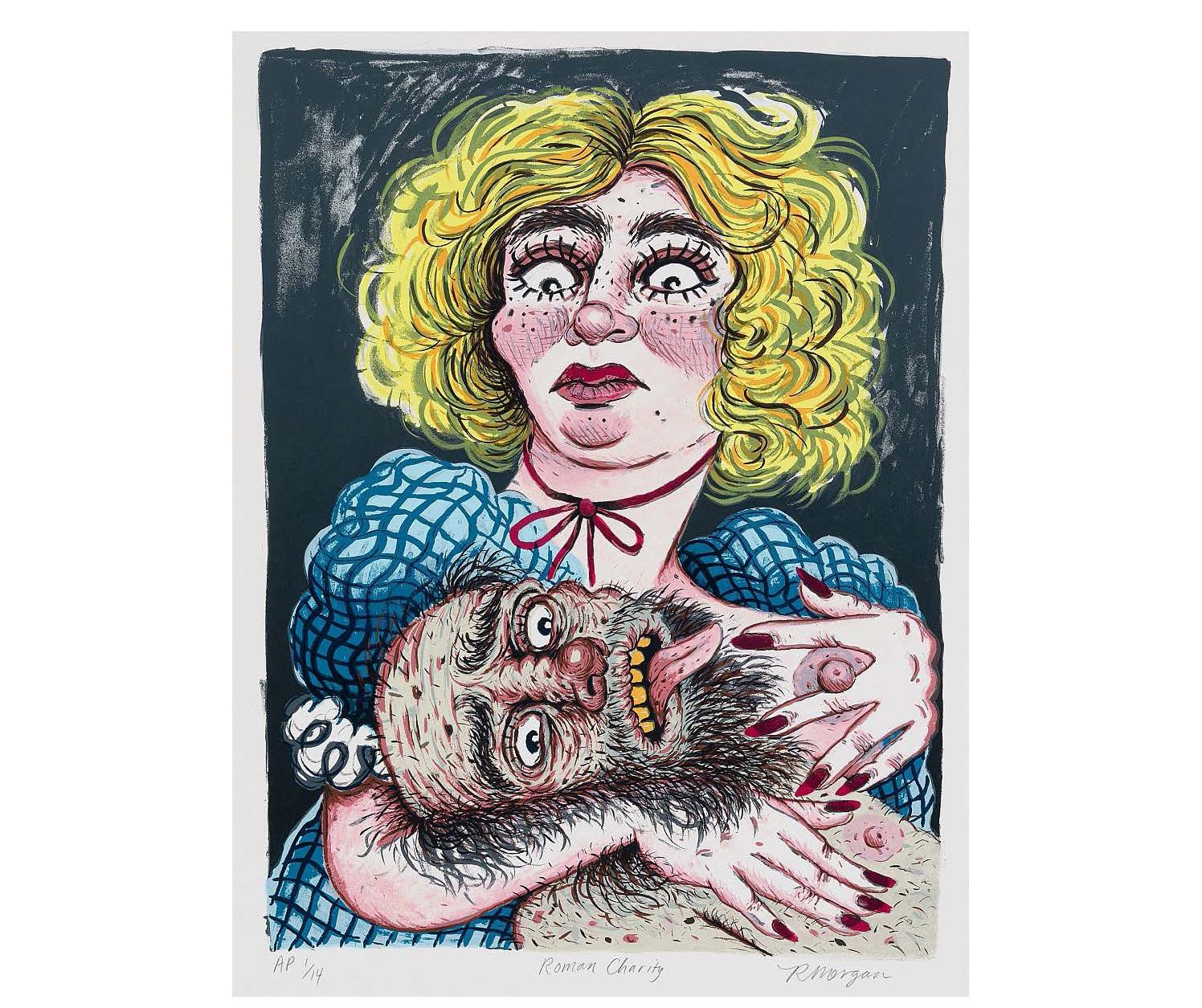
Artist Name
Rebecca MorganClearfield, PennsylvaniaLocation:
TOPICS:
Women and Gender streotypes, body
Coughing Corn Cob Smoking Girl, 2019
Letterpress print, Paper: 22h x 15w in Plate: 17.5h x 13.75w in, Edition 16 of 48, courtesy of the artist and and Asya Geisberg Gallery
Artist Bio:
Rebecca Morgan was born and raised in the center of Appalachia, within the mountains of Pennsylvania. Much of her artwork, focuses on themes and stereotypes of Appalachia. She works in painting, drawing and sculpture to explore these ideas. She completed her undergraduate degree at Bloomsburg University of Pennsylvania Graduate Degree from Pratt Institute in New York City. She has been featured in countless magazines and received many awards for her work.
Links:
https://www.asyageisberggallery.com/ artists/rebecca-morgan
Work Description:
Born in central Pennsylvania, Rebecca Morgan works in painting, drawing, and ceramics that subvert stereotypes of Appalachia. Imbued with folk tradition and a sly sense of humor, her work peels apart the simultaneous reverence and disgust for rural people. Stylistically, Morgan embraces the hyper-detailed naturalism of Dutch masters, as well as absurd, repulsive caricature suggestive of underground cartoonists like R. Crumb. Although they often contain modern clues, her characters and scenes evoke a romanticized, nostalgic America, nonexistent but wistfully recalled, much like Norman Rockwell’s illustrations. Morgan’s works question what such images were selling in their conception, and she gives her archetypal maids, hillbillies, and dandies the space to explore contemporary issues of women reclaiming their subjectivity, a pop-cultural false sense of romance, and ideas about masculinity, power, escapism, and hedonistic backwoods pleasure.
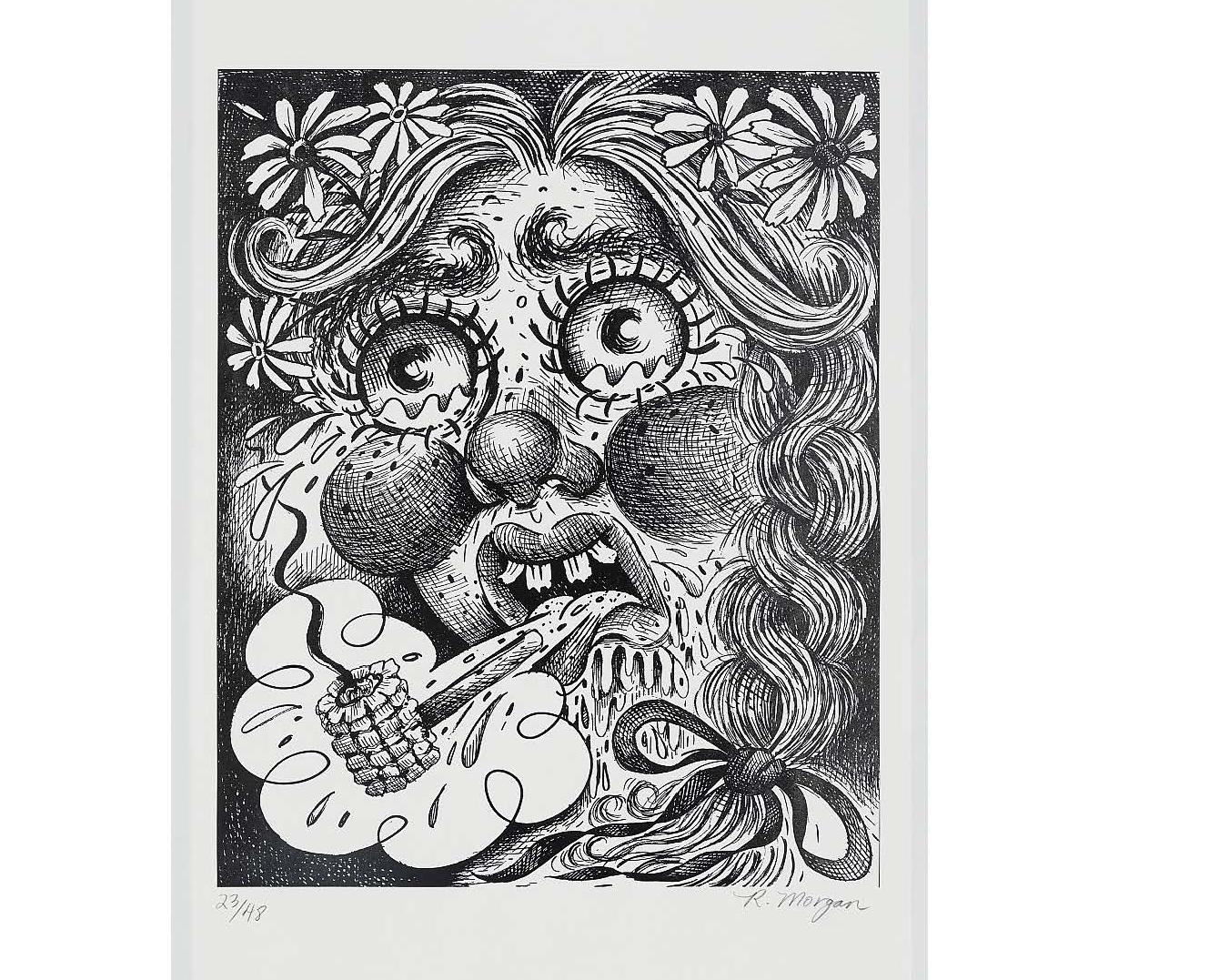
Clearfield, PennsylvaniaLocation:
TOPICS:
Women and Gender streotypes, body
OG Grizzled Man, 2016 Ink and watercolor on paper
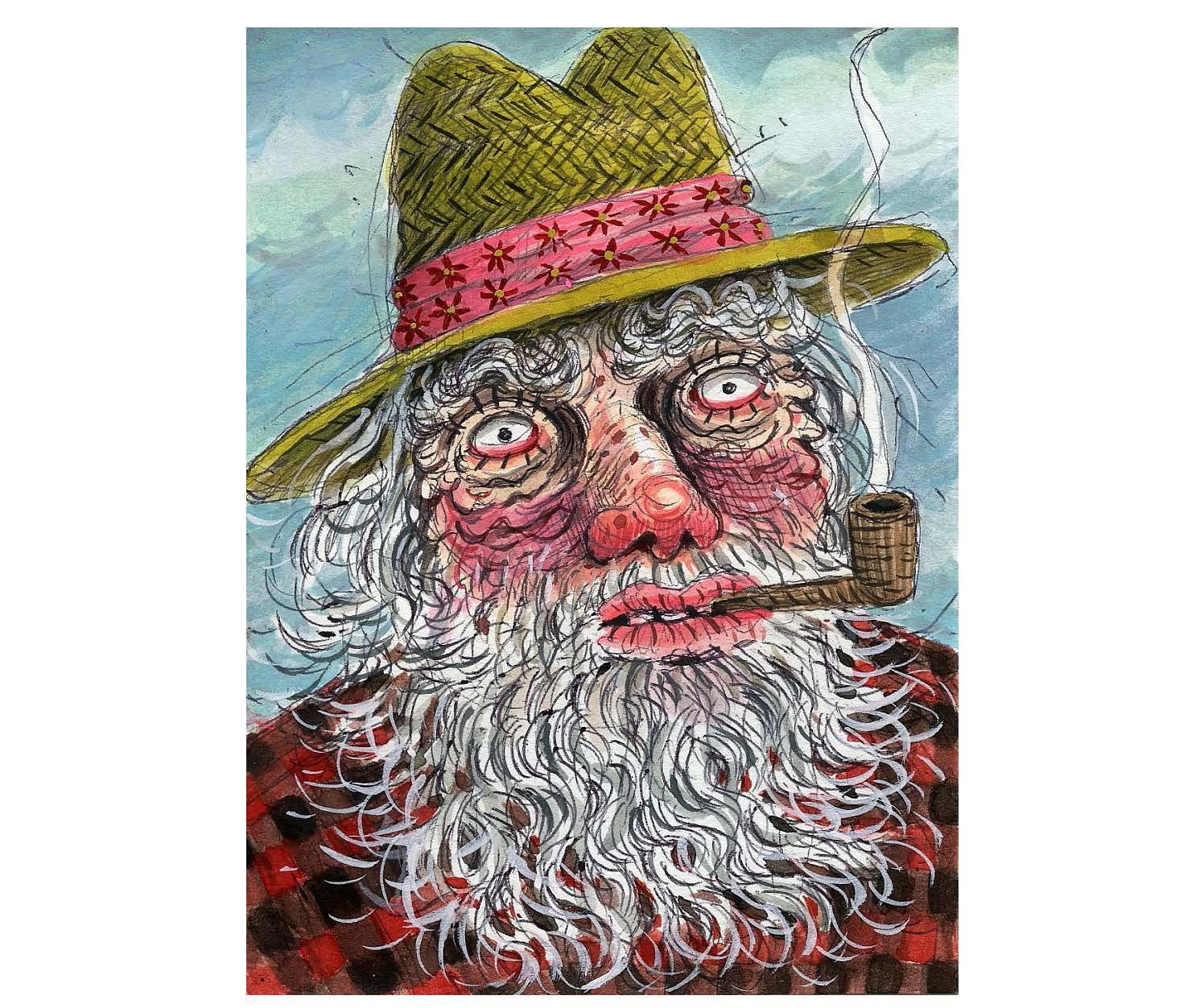
5.50h x 3.50w in, 13.97h x 8.89w cm courtesy of the artist and and Asya Geisberg Gallery
Artist Bio:
Rebecca Morgan was born and raised in the center of Appalachia, within the mountains of Pennsylvania. Much of her artwork, focuses on themes and stereotypes of Appalachia. She works in painting, drawing and sculpture to explore these ideas. She completed her undergraduate degree at Bloomsburg University of Pennsylvania Graduate Degree from Pratt Institute in New York City. She has been featured in countless magazines and received many awards for her work.
Links:
https://www.asyageisberggallery.com/ artists/rebecca-morgan
Work Description:
Born in central Pennsylvania, Rebecca Morgan works in painting, drawing, and ceramics that subvert stereotypes of Appalachia. Imbued with folk tradition and a sly sense of humor, her work peels apart the simultaneous reverence and disgust for rural people. Stylistically, Morgan embraces the hyper-detailed naturalism of Dutch masters, as well as absurd, repulsive caricature suggestive of underground cartoonists like R. Crumb. Although they often contain modern clues, her characters and scenes evoke a romanticized, nostalgic America, nonexistent but wistfully recalled, much like Norman Rockwell’s illustrations. Morgan’s works question what such images were selling in their conception, and she gives her archetypal maids, hillbillies, and dandies the space to explore contemporary issues of women reclaiming their subjectivity, a pop-cultural false sense of romance, and ideas about masculinity, power, escapism, and hedonistic backwoods pleasure.
Clearfield, PennsylvaniaLocation:
TOPICS:
Women and Gender streotypes, body
Happy Hippy Woman with Flower Crown, 2017 Ink and watercolor on paper
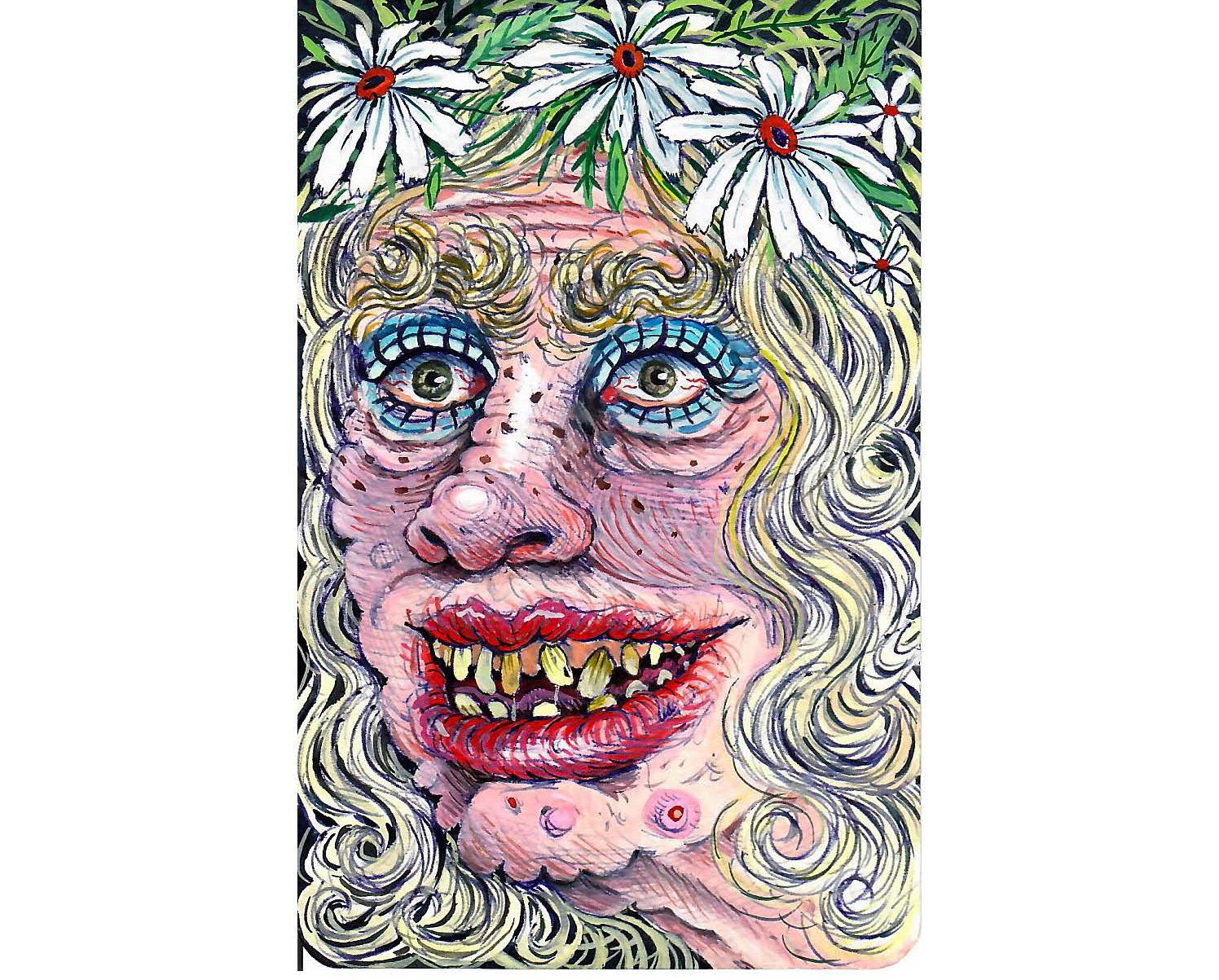
5.50h x 3.50w in, 13.97h x 8.89w cm courtesy of the artist and and Asya Geisberg Gallery
Artist Bio:
Rebecca Morgan was born and raised in the center of Appalachia, within the mountains of Pennsylvania. Much of her artwork, focuses on themes and stereotypes of Appalachia. She works in painting, drawing and sculpture to explore these ideas. She completed her undergraduate degree at Bloomsburg University of Pennsylvania Graduate Degree from Pratt Institute in New York City. She has been featured in countless magazines and received many awards for her work.
Links:
https://www.asyageisberggallery.com/ artists/rebecca-morgan
Work Description:
Born in central Pennsylvania, Rebecca Morgan works in painting, drawing, and ceramics that subvert stereotypes of Appalachia. Imbued with folk tradition and a sly sense of humor, her work peels apart the simultaneous reverence and disgust for rural people. Stylistically, Morgan embraces the hyper-detailed naturalism of Dutch masters, as well as absurd, repulsive caricature suggestive of underground cartoonists like R. Crumb. Although they often contain modern clues, her characters and scenes evoke a romanticized, nostalgic America, nonexistent but wistfully recalled, much like Norman Rockwell’s illustrations. Morgan’s works question what such images were selling in their conception, and she gives her archetypal maids, hillbillies, and dandies the space to explore contemporary issues of women reclaiming their subjectivity, a pop-cultural false sense of romance, and ideas about masculinity, power, escapism, and hedonistic backwoods pleasure.
Clearfield, PennsylvaniaLocation:
TOPICS:
Women and Gender streotypes, body
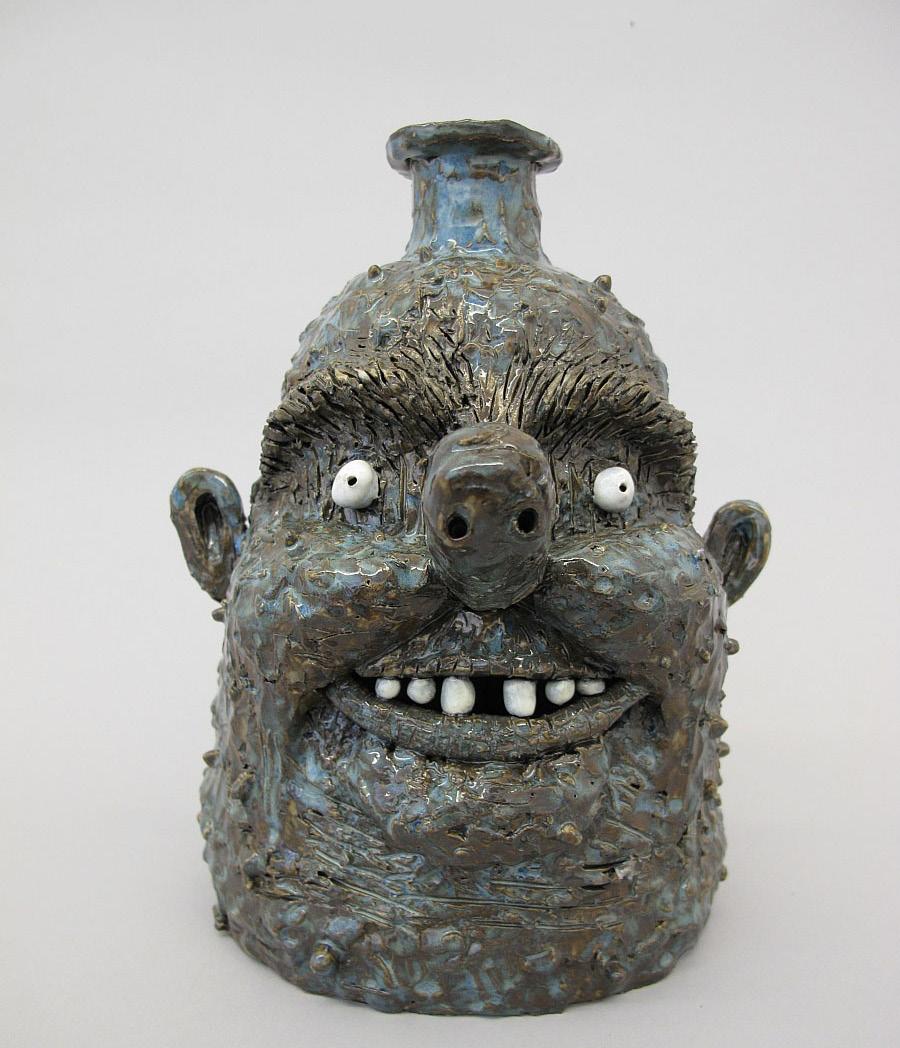
Terracotta, 9h x 7w x 8d in, 22.86h x 17.78w x 20.32d cm RM027-cer, courtesy of the artist and and Asya Geisberg Gallery
Artist Bio:
Rebecca Morgan was born and raised in the center of Appalachia, within the mountains of Pennsylvania. Much of her artwork, focuses on themes and stereotypes of Appalachia. She works in painting, drawing and sculpture to explore these ideas. She completed her undergraduate degree at Bloomsburg University of Pennsylvania Graduate Degree from Pratt Institute in New York City. She has been featured in countless magazines and received many awards for her work.
Links:
https://www.asyageisberggallery.com/ artists/rebecca-morgan
Work Description:
Born in central Pennsylvania, Rebecca Morgan works in painting, drawing, and ceramics that subvert stereotypes of Appalachia. Imbued with folk tradition and a sly sense of humor, her work peels apart the simultaneous reverence and disgust for rural people. Stylistically, Morgan embraces the hyper-detailed naturalism of Dutch masters, as well as absurd, repulsive caricature suggestive of underground cartoonists like R. Crumb. Although they often contain modern clues, her characters and scenes evoke a romanticized, nostalgic America, nonexistent but wistfully recalled, much like Norman Rockwell’s illustrations. Morgan’s works question what such images were selling in their conception, and she gives her archetypal maids, hillbillies, and dandies the space to explore contemporary issues of women reclaiming their subjectivity, a pop-cultural false sense of romance, and ideas about masculinity, power, escapism, and hedonistic backwoods pleasure.
Clearfield, PennsylvaniaLocation:
Howdy Jug, 2017
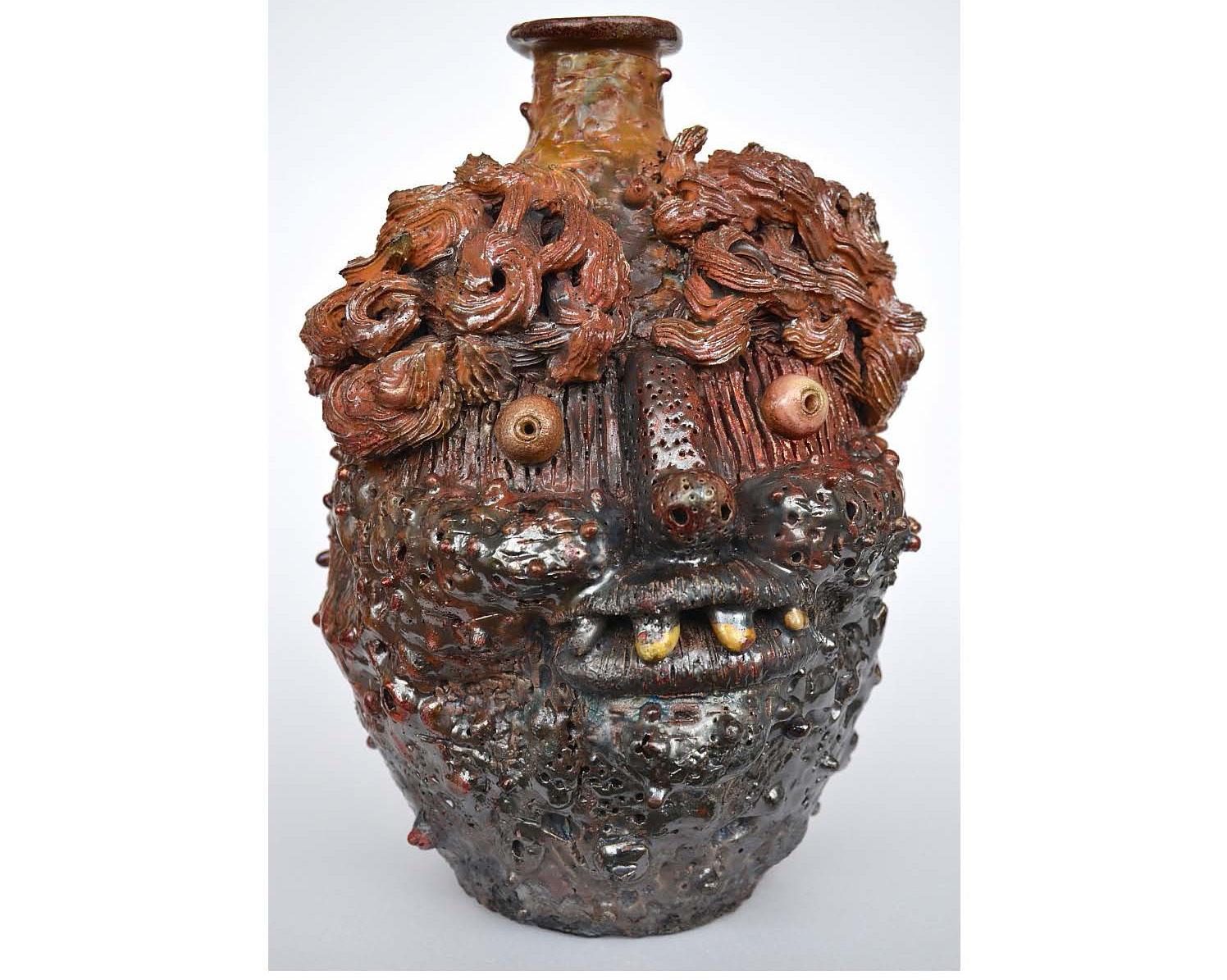
Raku ware
12h x 9.50w x 9.50d in 30.48h x 24.13w x 24.13d cm RM092-cer, courtesy of the artist and and Asya Geisberg Gallery
Work Description:
TOPICS:
Women and Gender streotypes, body
Artist Bio:
Rebecca Morgan was born and raised in the center of Appalachia, within the mountains of Pennsylvania. Much of her artwork, focuses on themes and stereotypes of Appalachia. She works in painting, drawing and sculpture to explore these ideas. She completed her undergraduate degree at Bloomsburg University of Pennsylvania Graduate Degree from Pratt Institute in New York City. She has been featured in countless magazines and received many awards for her work.
Links:
https://www.asyageisberggallery.com/ artists/rebecca-morgan
Born in central Pennsylvania, Rebecca Morgan works in painting, drawing, and ceramics that subvert stereotypes of Appalachia. Imbued with folk tradition and a sly sense of humor, her work peels apart the simultaneous reverence and disgust for rural people. Stylistically, Morgan embraces the hyper-detailed naturalism of Dutch masters, as well as absurd, repulsive caricature suggestive of underground cartoonists like R. Crumb. Although they often contain modern clues, her characters and scenes evoke a romanticized, nostalgic America, nonexistent but wistfully recalled, much like Norman Rockwell’s illustrations. Morgan’s works question what such images were selling in their conception, and she gives her archetypal maids, hillbillies, and dandies the space to explore contemporary issues of women reclaiming their subjectivity, a pop-cultural false sense of romance, and ideas about masculinity, power, escapism, and hedonistic backwoods pleasure.
Clearfield, PennsylvaniaLocation:
Watershed Jug, 2015
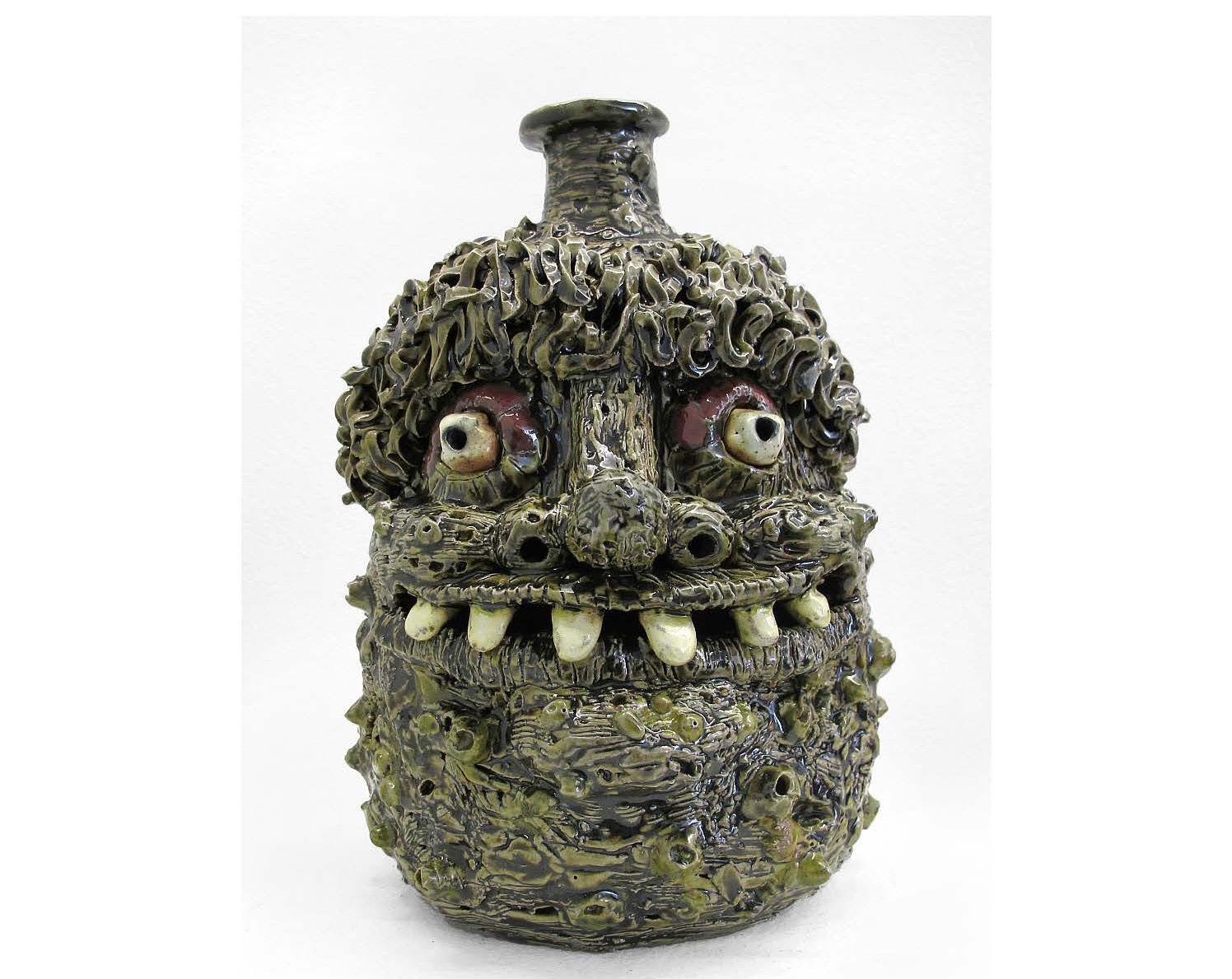
Salt glazed stoneware
9.50h x 6w x 7d in 24.13h x 15.24w x 17.78d cm RM068-cer
courtesy of the artist and and Asya Geisberg Gallery
Work Description:
TOPICS:
Women and Gender streotypes, body
Artist Bio:
Rebecca Morgan was born and raised in the center of Appalachia, within the mountains of Pennsylvania. Much of her artwork, focuses on themes and stereotypes of Appalachia. She works in painting, drawing and sculpture to explore these ideas. She completed her undergraduate degree at Bloomsburg University of Pennsylvania Graduate Degree from Pratt Institute in New York City. She has been featured in countless magazines and received many awards for her work.
Links:
https://www.asyageisberggallery.com/ artists/rebecca-morgan
Born in central Pennsylvania, Rebecca Morgan works in painting, drawing, and ceramics that subvert stereotypes of Appalachia. Imbued with folk tradition and a sly sense of humor, her work peels apart the simultaneous reverence and disgust for rural people. Stylistically, Morgan embraces the hyper-detailed naturalism of Dutch masters, as well as absurd, repulsive caricature suggestive of underground cartoonists like R. Crumb. Although they often contain modern clues, her characters and scenes evoke a romanticized, nostalgic America, nonexistent but wistfully recalled, much like Norman Rockwell’s illustrations. Morgan’s works question what such images were selling in their conception, and she gives her archetypal maids, hillbillies, and dandies the space to explore contemporary issues of women reclaiming their subjectivity, a pop-cultural false sense of romance, and ideas about masculinity, power, escapism, and hedonistic backwoods pleasure.
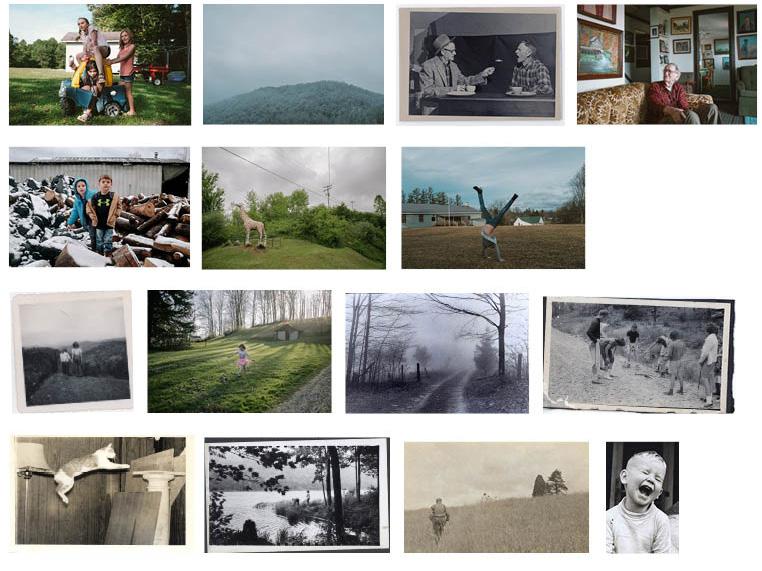 Elaine McMillion Sheldon
Elaine McMillion Sheldon
Tennessee
family in Nicholas County, West Virginia, where they have lived for
taken by Elaine McMillion Sheldon and her Uncle Roy McMillion.
storytelling,
Artist Bio:
Elaine McMillion Sheldon was born in a small town in Virginia and currently lives in Tennessee. She is a successful filmmaker who has been nominated for 6 Emmy’s and won countless other film awards. In addition to filmmaking, she currently works as an assistant professor of Cinema Studies at The University of Tennessee.
TennesseeLocation:
TOPICS:
Boxing,
Artist Bio:
Curren Sheldon currently lives with his wife Elaine McMillan Sheldon in Knoxville, Tennessee. He works with Elaine to create films such as the widely acclaimed “Heroin(e)” and “Recovery boys.” In addition to his filmmaking, he is a photographer whose work has been commissioned in countless magazines.
Links:
photograph, 2021, courtesy of the artist
Work Description:
“Stepping into the ring with no prior fighting experience, with the very real possibility of getting knocked out, is not for the faint of heart. But every year, hundreds of amateur fighters, both men and women, enter the ring to compete in Toughman with the hope of winning $1000 and the pride of being the top fighter in Central Appalachia.
One of the most popular sporting events in all of Appalachia, Toughman takes over 10 cities over 10 weekends every winter in West Virginia, drawing thousands of attendees at each stop. Dozens of fighters fight in a tournament-style competition, with winners on Friday night moving on to Saturday, sometimes fighting three or four times in a single day. In the ring, it’s a brawl, with untrained fighters throwing haymakers and hooks in lieu of professional jabs and crosses. Rock music blares during each 1-minute round while eight different ring girls compete between rounds for the chance to be named Top Ring Girl.
Toughman has become the biggest draw for entertainment in a region where you’ve always had to make your own fun. But with the economy lagging, jobs scarce, and addiction widespread, Toughman has also become an outlet for angst and a brutal quest for purpose.”


Sheldon

Location:
Doug Swift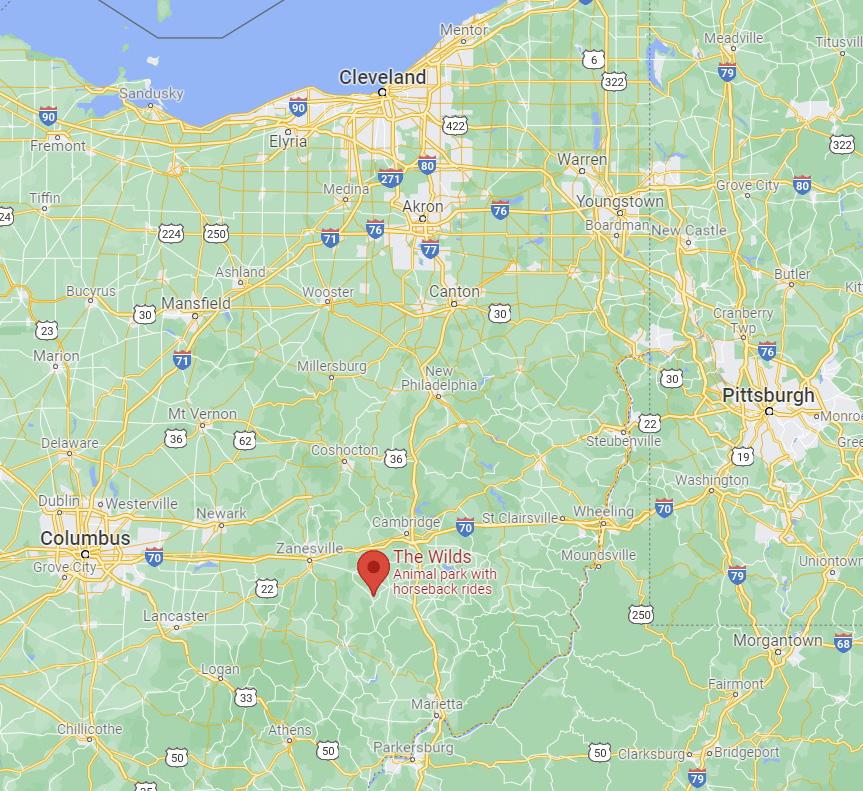
Coal Miner’s Son from 10,000 Acres project,, video excerpt, 3min, courtesy of the artist
Work Description:
TOPICS:
Storytelling, Wildlife, environment, animals, Ohio history
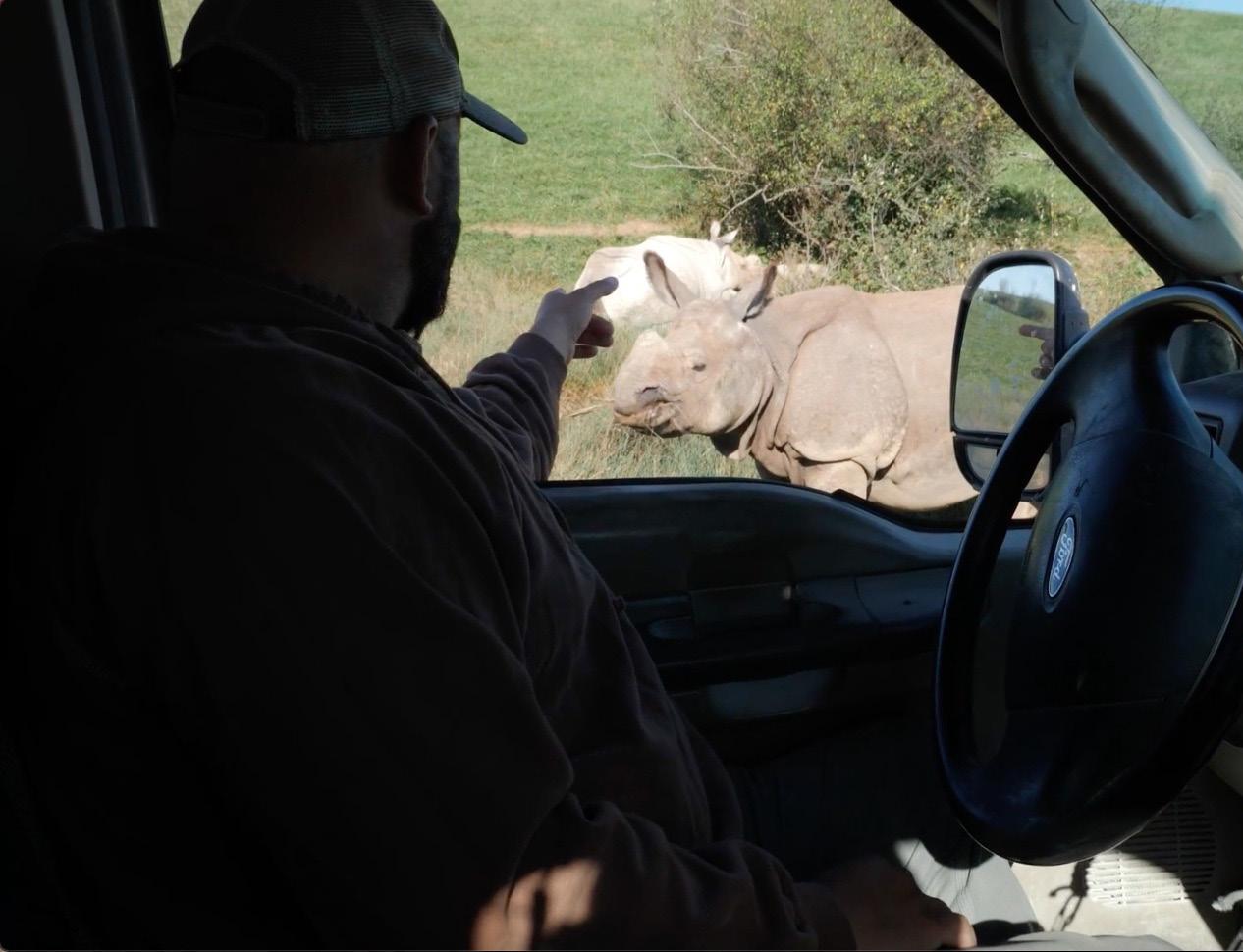
Artist Bio:
Doug Swift studied cinematography as an undergraduate, but majored in English with a creative writing emphasis, and went on to earn graduate degrees in creative writing from the Johns Hopkins Writing Seminars and the University of Iowa Writers Workshop. This is where he learned to tell stories with nuance and power.
He teaches at Denison University and contributes to the Narrative Journalism program.
Wild Iris Video films have been shown at the Big Muddy Film Festival at Southern Illinois University, the Columbus International Film and Video Festival, at numerous libraries, universities, and civic groups, and these videos maintain a vibrant presence on social media.
Links:
“10,000 Acres” will be an interactive documentary story to be published by 100 Days in Appalachia. It will tell the story about a patch of land in Meigs Township in Muskingum County, and the people who have lived on and worked that land. Currently, this is home to The Wilds, the largest endangered species preserve in North America. Previously, the land was strip-mined, and the locals who earned a living from that work are very proud. Prior to strip mining, the land was farmed, and those folks are also proud of their livelihood and lifestyle. Before that, the land was home to indigenous people. By telling these stories and placing them in relationship to each other, we hope all the stories become more poignant, and we hope there is much to reflect on regarding the human relationship with land at large.
Curt Coleman’s grandfathers and father worked for Central Ohio Power in pivotal roles. If mining had continued, he too would have been a coal miner. Instead, he is a Wildlife Manager for The Wilds, taking care of hundreds of rare and endangered species. This is part of his story.
Location:
Raymond Thompson JrCurrently living in Texas,, formerly located in West Virgina
TOPICS:
Black mining history, poetry (Muriel Rukeyser), environment, silica dust poisoning, storytelling.
Artist Bio:
Raymond Thompson Jr., is an artist, currently based in Austin, Texas. He earned a BA in American studies at the University of Mary Washington, and proceeded to earn an MA in journalism from the University of Austin Texas, and an MFA in photography from the University of West Virginia. He has had many freelance jobs for many news and media companies, including The New York Times, and Google, and NPR. Currently, he is an Assistant professor of Photojournalism at the University of Austin Texas.
Links:
12 Men - Appalachian Ghosts
Digital inkjet print on poster board - 72x40-inch - 2019, Courtesy of the artist
Work Description:
http://www.raymondthompsonjr.com/12-men https://www.blackinappalachia.org/podcast/ep isode/3e319e99/black-in-appalachia-a-hawksnest-halloween
“In the 1930s, migrant laborers came from all over the region to work on the construction of a 3-mile tunnel to divert the New River near Fayetteville, WV. During the process, workers were exposed to pure silica dust due to improper drilling techniques. Many developed a lung disease known as silicosis, which is estimated to have caused the death of nearly 800 workers. Up to two-thirds of those workers were African American. Besides a small plaque at the Hawks Nest State Park, which lists a significantly lower number than the actual number killed, there is very little to mark the site. There is also sparse visual documentation available about the event. There has been an effort to erase this tragic moment in history from the memory of West Virginia.


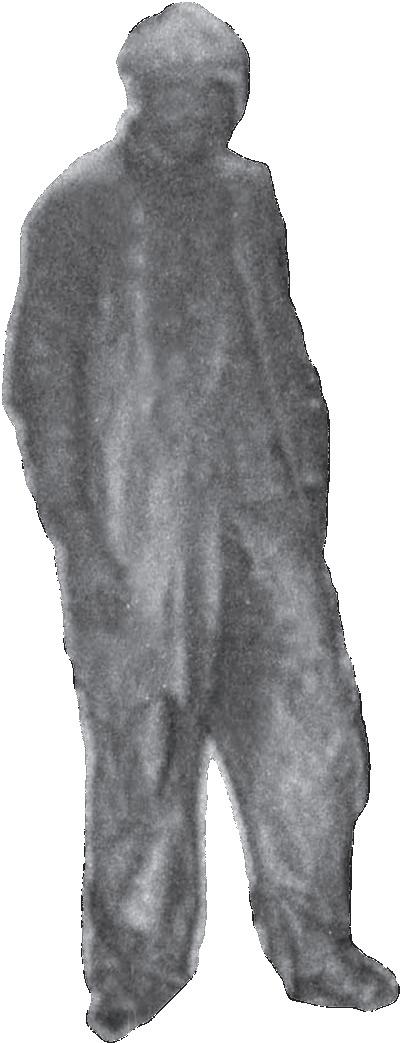
In Appalachian Ghosts, I explore visual possibilities of what that time and place looked like, using primarysource materials to recreate the workers’ experiences in photographs. I have also recontextualized and represented archive photographs, originally made to document the construction of the Hawks Nest Tunnel dam and powerhouse. The few people caught in the photographic archive were often nameless and voiceless workers. Specifically, I’m looking at what has been left out of African-American visual history, which to date has mainly been documented with a colonial gaze. From this standpoint, I have sought to re/create work that has been informed by and made from historical documents and photographs.
My research also focused on working with non-visual resources that inspired the creation of new works. I researched news clips, letters, poetry and other cultural resources looking for information that described the experience of working in the tunnel. I was particularly struck by a poem from Muriel Rukeyser’s book The Book of the Dead called “George Robinson: Blues:”
As dark as I am, when I came out at morning after the tunnel at night, with a white man, nobody could have told which man was white. The dust had covered us both, and the dust was white.
Rukeyser’s book, along with other primary-source documents, inspired a series of images that focuses on the silica dust that covered everything at the work site.” - From the artist website
Thorn CollaborativeArtist Name
Location:
Boone, North Carolina and Napanoch, New York
Bound video, 17:21 mins, Courtesy of the artists
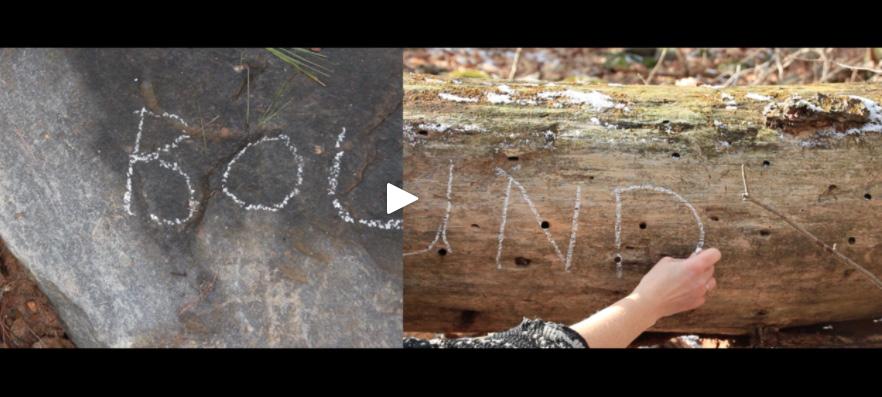
Links:
TOPICS:
Poetry, place, distance/closeness, isolation/intimacy, nature, landscape, dialogue, Covid pandemic
Artists Bio:
Interdisciplinary artists Erin Ethridge and Colleen Marie Foley have been working together as Thorn since 2015. As a collaborative, Thorn questions ideas of shared or composite identity, memory and body. Thorn takes their relationship as subject and tool, searching for places where the physical and psychic boundaries between them soften and become permeable. In the process, they negotiate dualities of distance/closeness, pleasure/pain, self/ other in pursuit of their limits. These efforts take the form of performance work, sculptural tools, and electronic media.
Erin Ethridge,, received a BFA at the University of Texas Tyler and went on to earn an MFA in sculpture/dimensional studies from the New York State College of Ceramics at Alfred University. https://www.erinethridge.com/about
Colleen Marie,, received a BFA at Boston University and also earned her MFA in electronic and integrated arts from Alfred University http://www.colleenmariefoley.com/about-1/
Location:
Artist Name Boone, North Carolina and Napanoch, New York
Made during a period of quarantine and isolation due to the Pandemic, Bound is a poem about longing for a loved one from afar and finding solace in both technology and the natural world. From our respective homes and video channels, we seek visual analogies of intimacy embedded in our bodies and the landscapes of the Catskills and the Blue Ridge. We attempt to breach the space between us, collapsing 700 miles of the Appalachians into an infinitesimal edge. By treating this inner edge of a two channel video as both a meeting point and fault line, Bound explores a digital realm where space between phrases, bodies, mountain ranges, and time frames can be folded and rearranged, fragments sutured and healed.
We began working on Bound with the intention of expanding Breaching Tool No. 1: Shrouds into a longer work that was a deeper exploration of place. In Shrouds we were thinking about invisibility and dissolving ourselves into a landscape as a way to be together, and we used the Blue Ridge Mountains as a backdrop. Wanting to engage more thoughtfully with the landscape in Bound, we started thinking about geology and felt like there was a lot of poetry in the processes of mountain formation that related back to our personal mythology around Thorn and the energy that animates our collaboration. From there we began to see the Appalachian mountain range as a vein or tether connecting the two places we live (Boone, NC in the Blue Ridge and Napanoch, NY in the Catskills). That was what got us thinking about immersing ourselves in our two separate landscapes as a means of connecting with each other in spite of the 700 miles between us, and what ultimately inspired the poem that structures Bound.
From the outset we envisioned Bound as a two channel video because we wanted the side by side dialogue of our two home environments. In a past series called Conflations we had played with connecting ourselves across distance by cutting the single channel video back and forth between us in the middle of the movements. So when we started planning for Bound, we were sort of already imagining gestures that emphasized the synchronization of our body movements, but the seam between the two video channels presented a new opportunity. That edge excited us both conceptually and formally — we’ve often been drawn to edges of things (of bodies, of spaces, of the self, etc.) as sites where boundaries can be perforated or dissolved, and we hoped that visually it would anchor the images and reveal both the synchronicity and the disjunction of our actions. It also reminded us of the edges of video in video chat programs like Zoom, FaceTime, etc. which have been so significant for the way we experience our lives and loved ones during the pandemic. And though our work has always dealt with themes of distance/ closeness and isolation/intimacy, the global pandemic really brought those themes to the fore and made that feeling of separation and desire for intimacy so collectively relatable.
Bound in flesh, a cruelty
Underneath, a rift that aches, Touching the fault line Between homes
Michael Croley is the author of Any Other Place: Stories, winner of the James Still Award from the Fellowship of Southern Writers and the Weatherford Award. He is also the co editor (with Jack Shuler) of Midland: Reports from Flyover Country. His reporting, stories, and essays have appeared in Esquire, The New York Times, Bloomberg Businessweek, VQR, The Paris Review, Kenyon Review, LitHub, Narrative, and elsewhere. He is the recipient of grants from the National Endowment for the Arts, the Ohio Arts Council, the Kentucky Arts Council, and the Sewanee Writers’ Conference. He teaches at Denison University and is on the visiting faculty at the Vermont College of Fine Arts.
Jack Shuler is an author, independent journalist, and essayist. He’s the editor of Between Coasts and is associate professor of English at Denison University where he teaches American literature, Black Studies, and the Journalism program. With colleague Michael Croley he organizes and hosts the Between Coasts Forum at Denison University.
He is the author of Calling Out Liberty: The Stono Slave Rebellion and the Universal Struggle for Human Rights (Mississippi University Press, 2009); Blood and Bone: Truth and Reconciliation in a Southern Town (University of South Carolina Press, 2012); The Thirteenth Turn: A History of the Noose (PublicAffairs, 2014); Midland: Reports from Flyover Country, edited with Michael Croley (Tiller/Simon and Schuster, 2020); and This is Ohio: The Overdose Crisis and the Front Lines of a New America (Counterpoint, 2020).
Shuler’s writing has appeared in The Atlantic, The Christian Science Monitor, Salon, Los Angeles Times, Truthout, Cleveland Plain Dealer, Journal of Southern History, Columbia Journal of American Studies, Hanging Loose, and Failbetter, among others.
Before teaching at Denison, Shuler taught at Brooklyn College and worked as a project and development director for the Brooklyn College Community Partnership, an organization working to expose youth in under-served communities to the college experience.
Twitter: @jackshuler, Instagram: @jackshulerauthor, Email: shulerj_at_denison.edu
Doug Swift holds an MA from the Johns Hopkins Writing Seminars and an MFA from the University of Iowa Writers Workshop. He has published poetry and fiction in such publications as the American Poetry Review, PIVOT, the Artful Dodge, West Branch, and many more. He transitioned to documentary film storytelling, created Wild Iris Video, a vehicle to tell local stories to a local audience, and project those stories to larger audiences. Some of his longer documentaries include Up River, about the Newark Think Tank on Poverty, and Breathe Free, about artists in Central Ohio advocating on behalf of refugees in the community. He partnered with journalist Jack Shuler on his current film, ‘Til the Wheels Fall Off, about a semi-pro football team in Portsmouth, Ohio, which serves as a surrogate family in a region ravaged by the opioid crisis. A teacher dedicated to passing on the skills of storytelling, in all its forms, he has taught for over 30 years at Muskingum University, Ohio University Zanesville, and Denison University.
100 Days in Appalachia is an independent, nonprofit news outlet incubated at the Media Innovation Center of West Virginia University Reed College of Media in collaboration with West Virginia Public Broadcasting (WVPB) and The Daily Yonder of the Center for Rural Strategies in Kentucky. We have an open-source, co-publishing model and share content from Appalachia’s diverse communities with re gional, national and international media organizations. Read more about 100 Days in Appalachia’s mis sion, funding and collaborating partners here.
The Appalachian Retelling Project was born out of the belief that stories - Appalachian stories - have power. Stories of resilience and ingenuity in times of hardship. Stories of the unique knowledge, communities, and people held within these hills. Stories that challenge the tired narrative that Appalachia is a place incapable of solving its own problems.
Appalachia is a place filled with incredible storytellers - yet the narrative is often driven by individuals and organizations who don’t know what it means to be from this place. It’s time to change that. We’re sharing stories that smash stereotypes, uplift unheard voices, and give an honest, nuanced glance into what it means to be from the mountains. We’re re-telling the story of Appalachia - and this time, it’s on our terms.
Elon is a filmmaker and writer from Pikeville, KY with a passion for underrepresented (and misrepresented) populations in media. Growing up in Eastern Kentucky, she saw firsthand how negative, stereotypical images of her area had the power to harm those around her, and she wanted to do something to change it. She hopes her work might do just that.
Elon is an alum of Western Kentucky University and MIT, where she studied media representation and documentary film. In her free time, she enjoys travel, music, and teaching others how to correctly pronounce her name. (Hint: It’s not like Elon Musk!)
https://www. theappalachianretellingproject. com/post/guest-post-reconciling-my- immigrant-roots-and-appalachian- upbringing
Krishna reflects on growing up Hindu in Appalachia and how she navagated friendship, holidays, food, and home.
Krishna A Reconciling My Immigrant Roots and Appalachian Upbringing
https://www. theappalachianretellingproject. com/post/guest-post-why-i-never-left- appalachia
https://www. theappalachianretellingproject. com/post/guest-post-kentucky-is-my- fate
https://www. theappalachianretellingproject. com/post/guest-post-split-dogs-and- skunk-funerals
https://www. theappalachianretellingproject. com/post/guest-post-the-hundred-year- flood
Reflections on why the writer loves living in in Appalachia
Reflections on why the writer loves Appalachia and how she plans on returning again
Tall tales in the Appalachian tradition
Memories of childhood in Pikeville, KY in 50s and 60s
Variety of videos about Black Appalachia in South Eastern, Ohio
The ensemble of African-American writers challenge simple notions of an all white Appalachian region and culture while drawing on traditions such as the Harlem Renaissance, the Black Arts Movement, and experiences of the African Diaspora.
Though Appalachia's people are as diverse as its terrain, few other regions in America are as burdened with stereotypes.
https://www.kentuckypress. com/9780813175232/black-bone/
Author Frank X Walker coined the term "Affrilachia" to give identity and voice to people of African descent from this region and to highlight Appalachia's multicultural identity. This act inspired a group of gifted artists, the Affrilachian Poets, to begin working together and using their writing to defy persistent stereotypes of Appalachia as a racially and culturally homogenized region.
https://youtu.be/8qI2cUkhGEY
https://youtu.be/DCanT3QcDS4
https://youtu.be/ARGAsxFaJo4
Guest Post: Why I Never Left Appalachia
Guest Post: Kentucky Is My Fate
Guest Post: Split Dogs and Skunk Funerals
Guest Post: From the Front Porch, 1955
Various
Tipper P.
Immigrant perspective. Hindu heritage in Pikeville, KY
Storytelling, blog
Appalachia Retelling Project
Appalachia appreciation
Storytelling, blog
Appalachia Retelling Project
Rachel P.
Appalachia appreciation, code switching
Storytelling, blog
Appalachia Retelling Project
Susanna C.H.
Saundra C.T.
Various
Jean Donohue and Fred Johnson Coal Black Voices
Storytelling
Storytelling, blog
Appalachia Retelling Project
Storytelling
Storytelling, blog
Appalachia Retelling Project
Southwestern Ohio
Video Journalism
Documentary about Black poets in Appalachia
Black Bone
Bianca Lynne Spriggs and Jeremy Paden
25 Years of Affrilachian Poets
Documentary
Black in Appalachia
Coal Black Voices
Book of Poetry
Black Bone
KNOXVILLE'S
RED SUMMER: THE RIOT OF 1919 chronicles the unrest that occurred in Knoxville following the murder of Bertie Lindsey and the attempted lynching of the accused, Maurice Mays. Knoxville's Red Summer includes rediscovered news reel footage of the city, post-riot from 1919.
Knoxville's Red Summer: The Riot of 1919
Black in Appalachia Projects
Racial Tension, politics, violence
Documentary, 26 minutes
Black in Appalachia details the history of the establishment of coal camps & towns in the Eastern Kentucky coal fields & the in migration of African American laborers to the Mountain. Founded in 1969, the EKSC is perhaps one of the longest standing African American organizations dedicated to solely social purposes.
Many people may not know that President Lincoln's Emancipation Proclamation did not apply to enslaved people in the state of Tennessee. Despite this, then-Military Governor, Andrew Johnson emancipated his own slaves on the 8th of August, 1863. This event set off a century and a half long tradition of freedom celebrations that continues today in East Tennessee.
The Eastern Kentucky Social Club
Black in Appalachia Projects
Life of African Americans in the coal towns, migration to the cities and the community built.
Documentary, 54 mins
8th of August: Tennessee's Celebration of Emancipation
Black in Appalachia Projects
History, Emancipation celebrations.
Documentary, 27 mins
Black in Appalachia
Black in Appalacihia
Black in Appalachia
Link
https://www.blackinappalachia.org/podcast
https://www.blackinappalachia. org/podcast/episode/2d815092/black-in- appalachia-no-neutral-ground
https://www.blackinappalachia. org/podcast/episode/2f329aef/black-in- appalachia-power-and-the-west-virginia- coalfields
https://www.blackinappalachia. org/podcast/episode/389897cb/black-in- appalachia-appalachian-drag
https://youtu.be/dgTj0tZLNlk
https://youtu.be/WvgQF0TW5Zo
https://www.youtube.com/watch?v=m8e1BnyCTdA
https://www.youtube.com/watch? v=Gy5QV511YfQ
https://wvminewars.org/
http://luaproject.org/mexison and https: //www.pbs.org/video/lua-project-leslie-m- scott-jones-loopox/
https://youtu.be/WowiDSKRALM
Description
Having long been in this region, Black Appalachians remain mostly invisible, while the dominant narratives of Appalachia depict an overwhelming, white cultural homogeneity. The Black in Appalachia Podcast challenges these misconceptions by highlighting how Black families have shaped and have been shaped by the region. Through historical and contemporary stories of people, places and experiences, hosts Enkeshi ElAmin and Angela Dennis interrogate what it means to be Black in Appalachia, creating space where under-told stories can be heard and Black identity can be reclaimed.
In this episode we're talking about the history of confederate monuments, their removal and impact on our educational landscape with C.J. Hunt the director of Neutral Ground.
Black in Appalachia is talking Black life in West Virginia coal camps, the Mine Wars and the struggles for Black political power and workers’ rights, with excerpts from our visit to The West Virginia Mine Wars Museum, retired coal miners and the one and only Dr. Joe Trotter, Jr
Various Episodes
Hosts: Enkeshi ElAmin and Angela Dennis
Various Episodes
No Neutral Ground
Black in Appalachia
Meaning and history of Confederate monuments and symbolism in Appalachia
Podcast
Black in Appalachia Podcast
Podcast
Black in Appalachia Podcast
Black in Appalachia: Power and the West Virginia Coalfields
Hosts: Enkeshi ElAmin and Angela Dennis
Black in Appalachia: Appalachian Drag Enkeshi and Pumpkin talk with Drag Queens about the ups, downs and being Black in the Appalachian Scene
Hosts: Enkeshi ElAmin and Angela Dennis
From her garden nestled in a holler in Pikeville, KY, Lauren May (creator of the cooking blog Must Love Herbs) discusses how she came into her love for gardening and cooking, and how her blog featuring traditional Appalachian cuisine with a twist is helping combat stereotypes of the region.
Lauren: Combatting Stereotypes
Through Cultural Traditions | The Appalachian Retelling Project
Nathan Hall has always had a connection to his home in Eastern Kentucky, and now he's working to create innovative opportunities for the region through Pine Mountain Remedies, an Appalachian hemp company with a focus on sustainability and local economic development.
Nathan: Sustainability & Economic Growth in Appalachia | The Appalachian Retelling Project
From atop a mountain in Pikeville, KY, local entrepreneur and small business owner Rusty Justice explains how he feels he has found success because of his location in Appalachianot in spite of it.
Rusty: Finding Success in Appalachia | The Appalachian Retelling Project
From her backyard in South Williamson, KY, Harvard graduate student and Policy and Programming Coordinator for the Muslim Public Affairs Council Iman Ali talks about growing up as a Muslim woman of color in Appalachia and how she hopes to improve the community she loves so much.
Iman: Navigating Identity as a Muslim Appalachian | The Appalachian Retelling Project
This museum has exhibitions that explore life in coal camps, different strikes over the years, and archeological objects found.
Artists Estela, David and Zenen spent time together, during the fall of 2018, interviewing Latino immigrants in the Shenandoah Valley and Central Virginia, collecting their stories, and turning them into song. The medium for this project, was the musical style known as Son Jarocho, which is afro-mestizo musical form emanating from 18th Century Veracruz, Mexico.
Film about the removal of confederate monuments in the appalachia and the south.
Four years after being elected to the Parkersburg City Council with help from progressives, Eric Barber was all in for Trump. Film by Chris Jones and P. Nick Curran in partnership with Intercept and 100 Days in Appalachia.
Elon Justice
Workers rights history. Coal.
Drag in Appalachia
Podcast
Black in Appalachia Podcast
Podcast
Black in Appalachia Podcast
Elon Justice
Personal Narative and food
Documentary 4 mins
Appalachia Retelling Project
Documentary
Growing hemp sustainably
na
Rusty
Iman
INTRODUCING MEXILACHIAN SON
Reparations Now!
Neutral Ground
What Drove a West Virginia Democrat to Storm the Capitol on January 6?
Business
6 mins
Appalachia Retelling Project
Documentary
na
Muslim identity in KY
West Virginina Coal Miner wars for workers rights
Lua Project
Videos about creating a new type of music influenced by
Ashley M. Jones
explore racial inequity and racism.
6 mins
Appalachia Retelling Project
Documentary 7 mins
Appalachia Retelling Project
Museum
West Virginia Mine Wars Musuem
Music
CJ Hunt
Intercept and 100 Days in Appalachia
Confederate monuments
Book of Poetry
WV Democrat in insurection
Documentary
Lua Project
Reparations Now!
Neutral Ground
100 Days In Appalachia Documentary 22 mins
